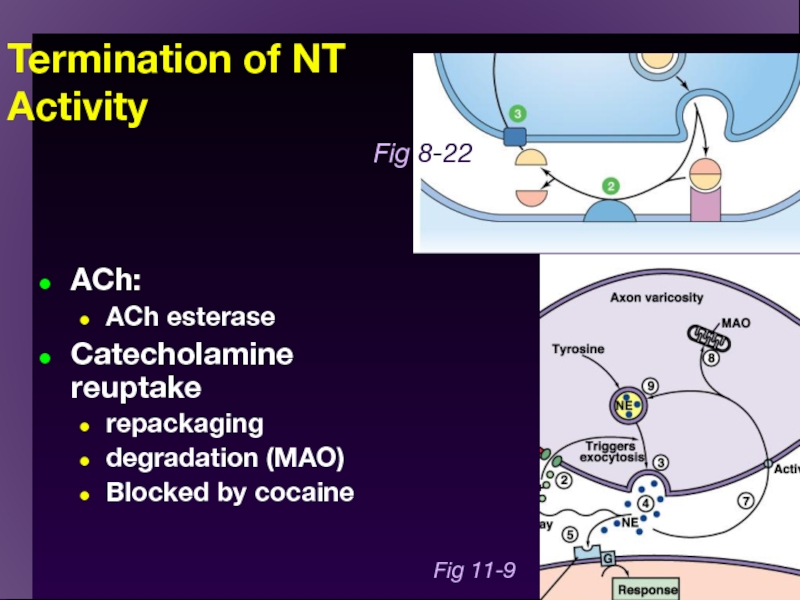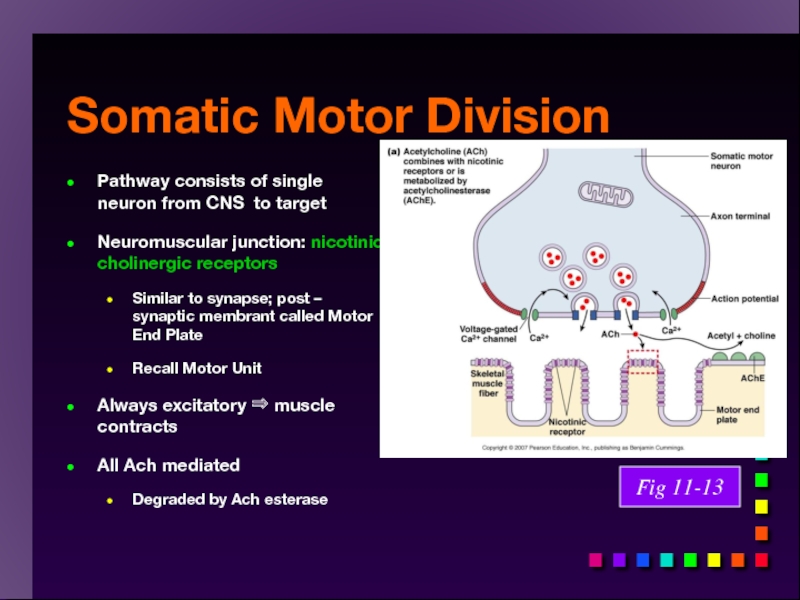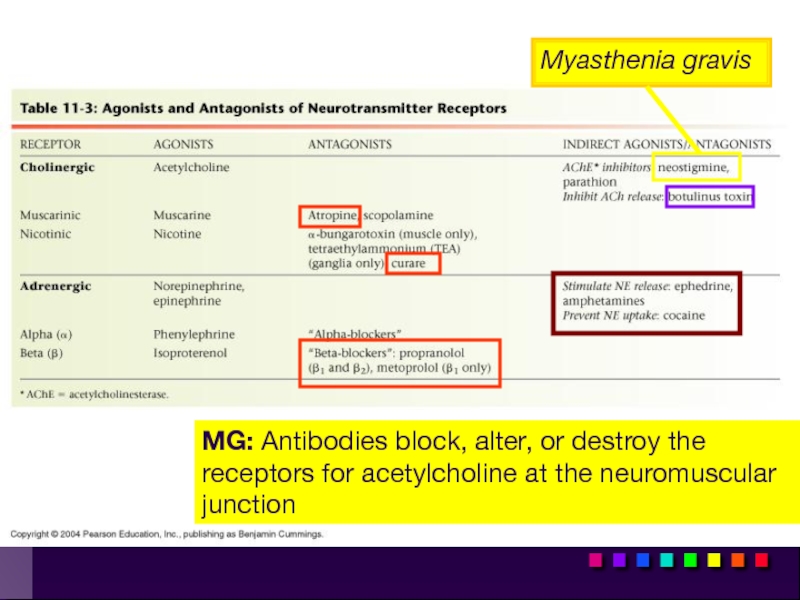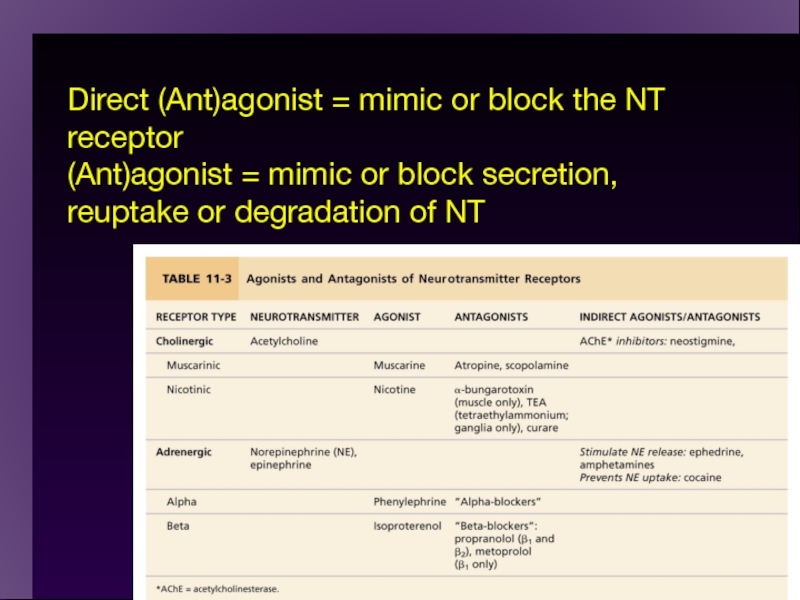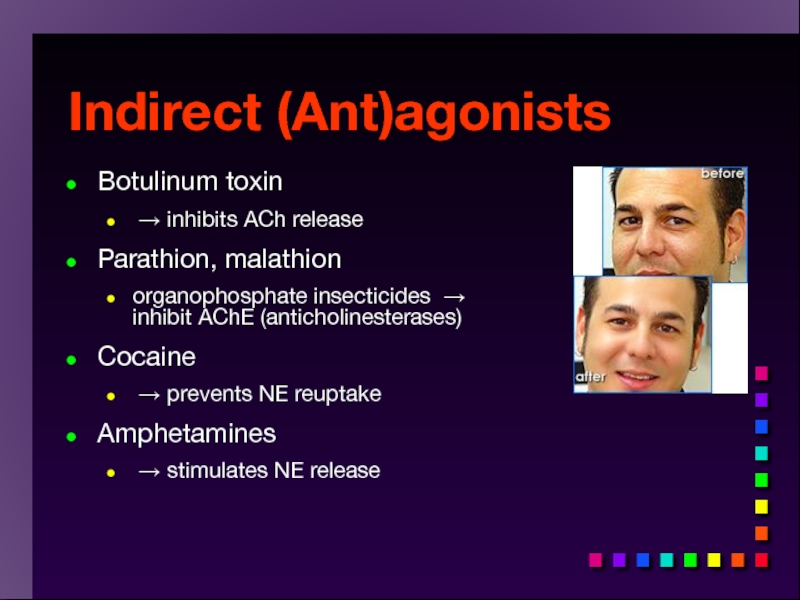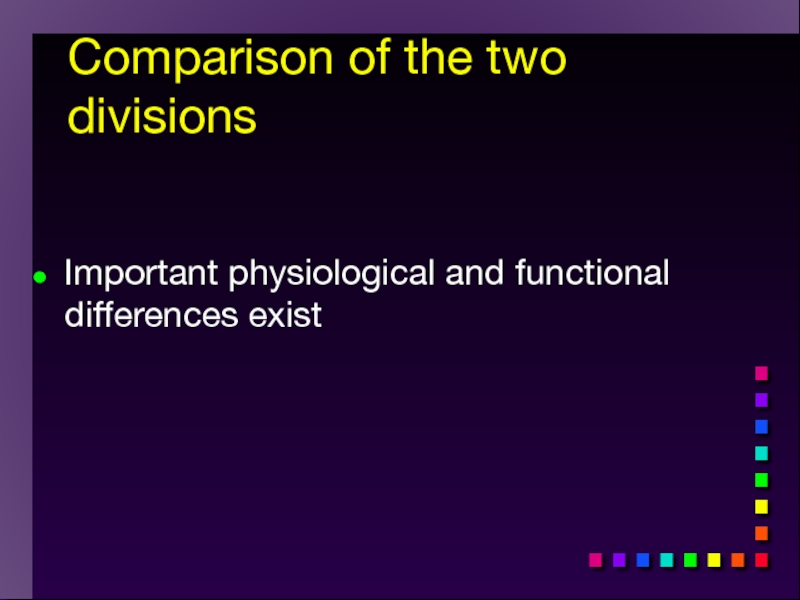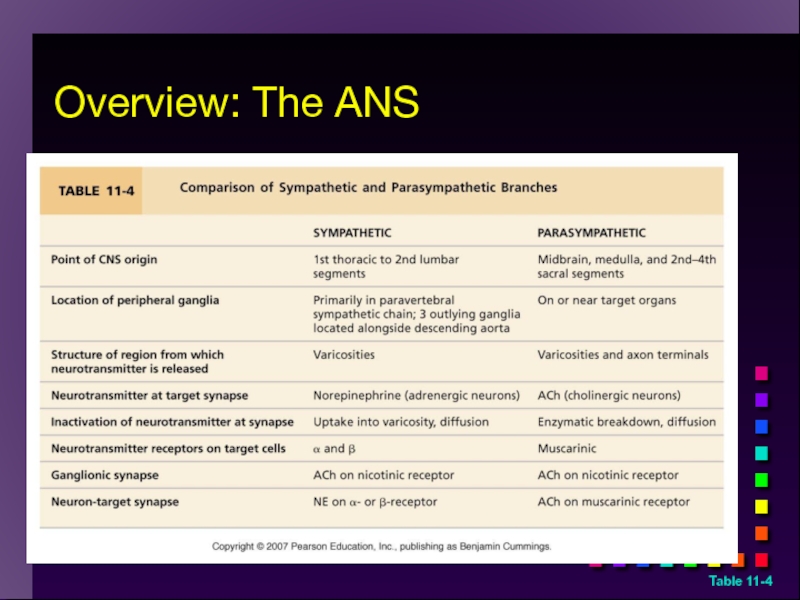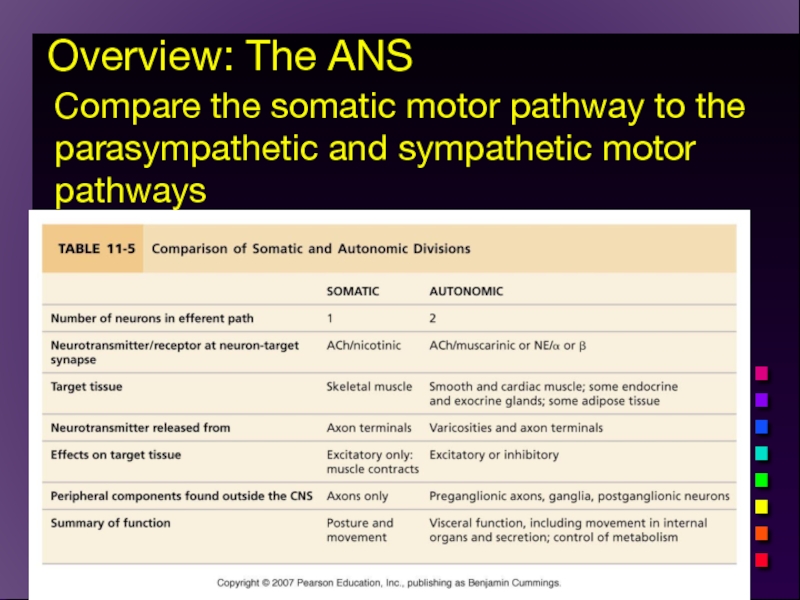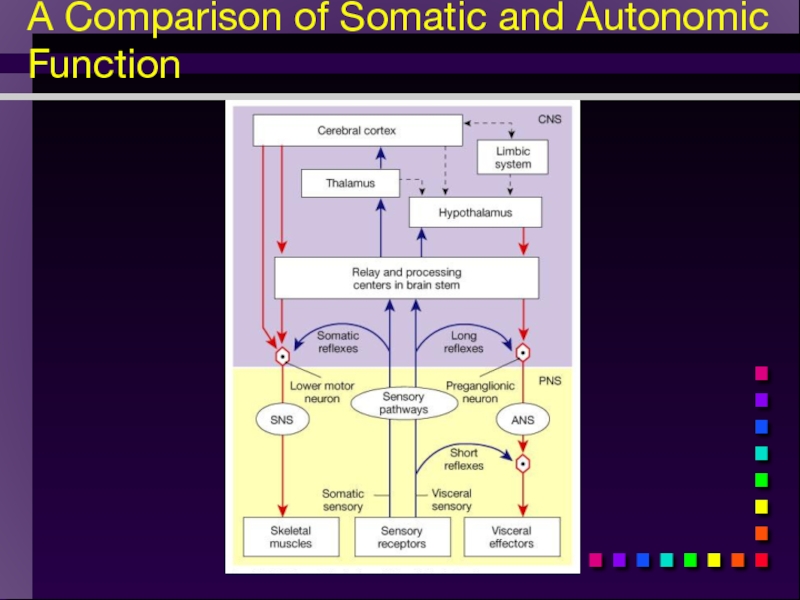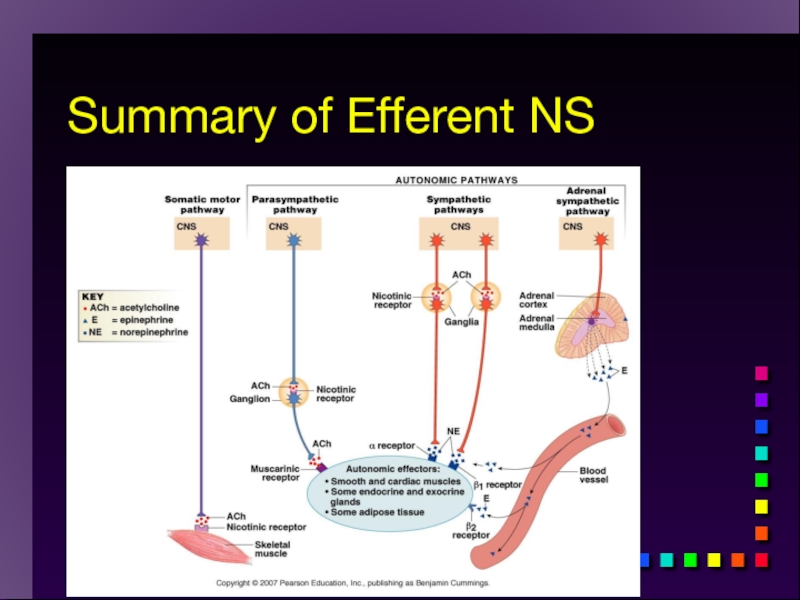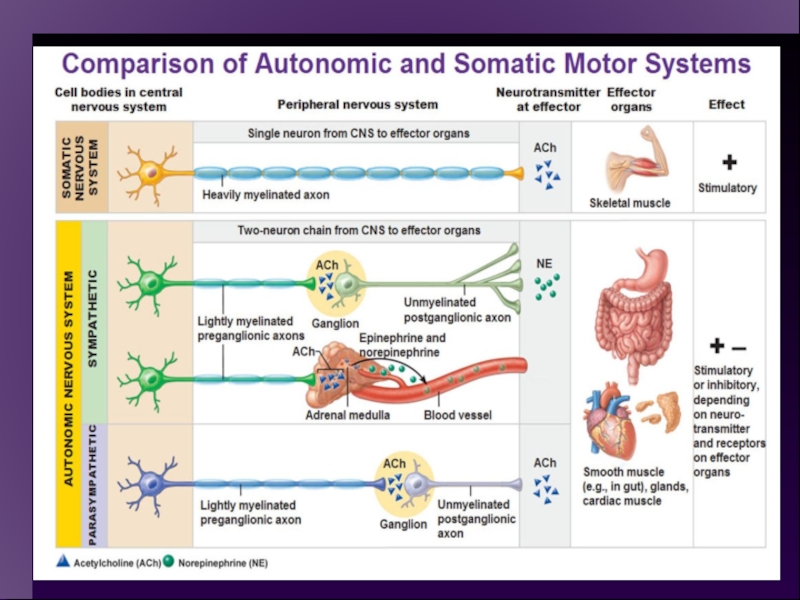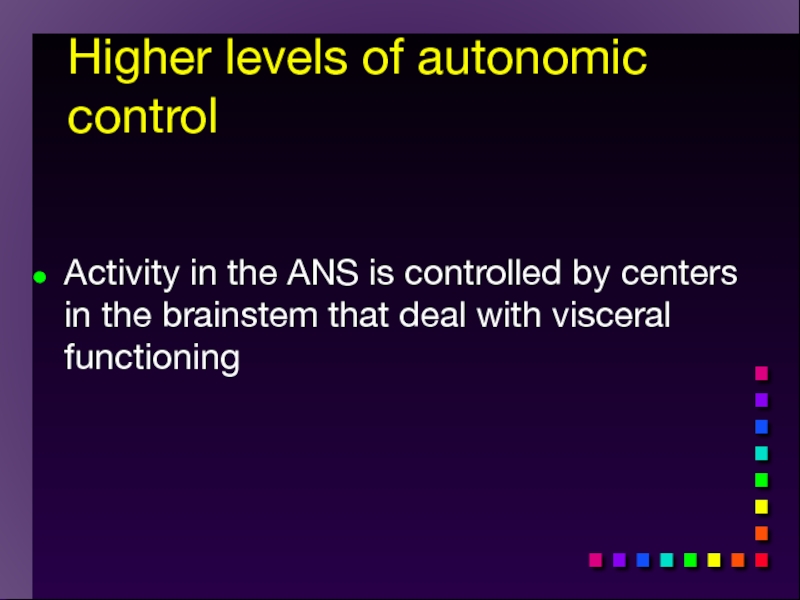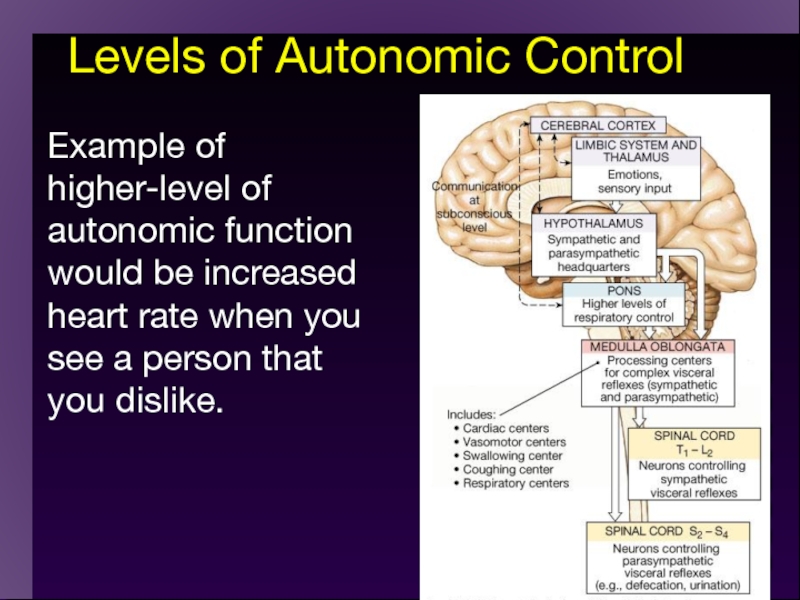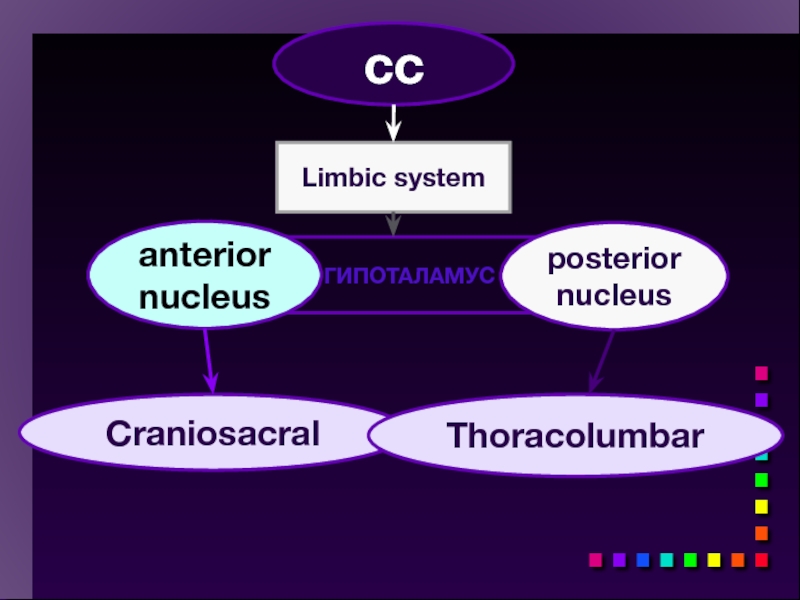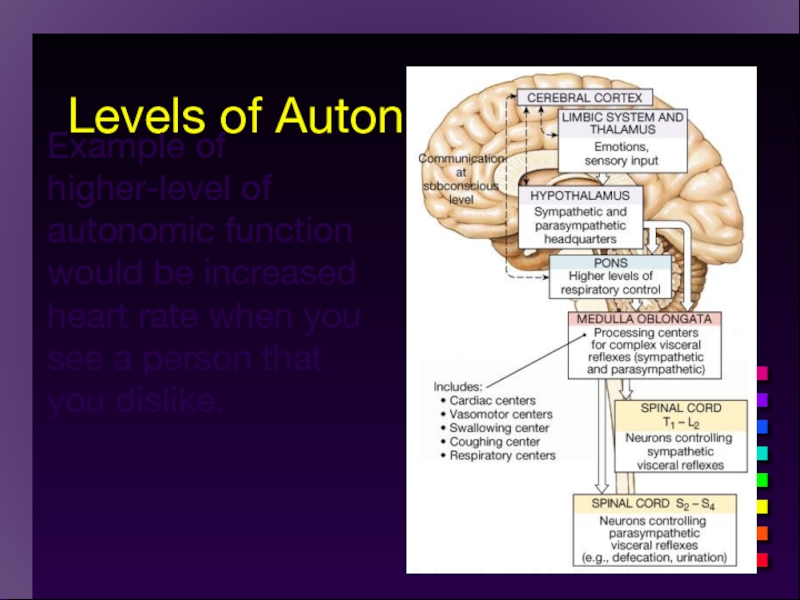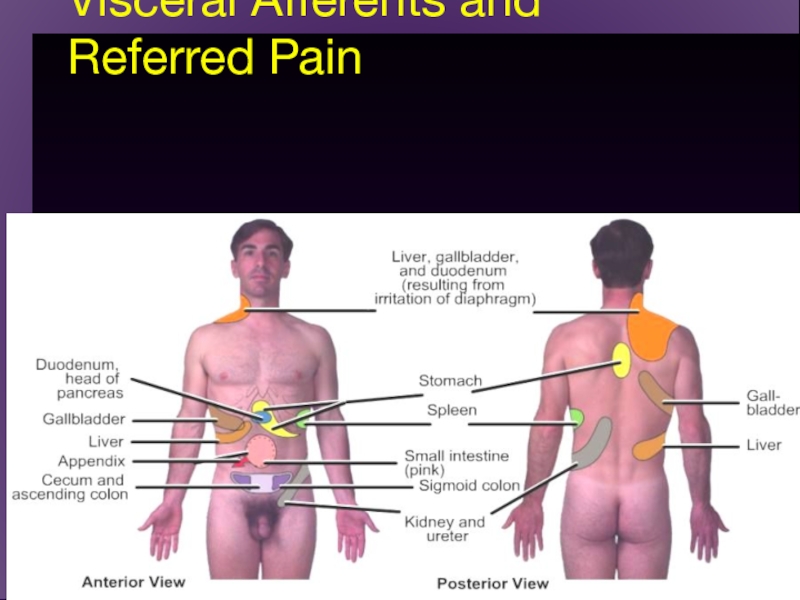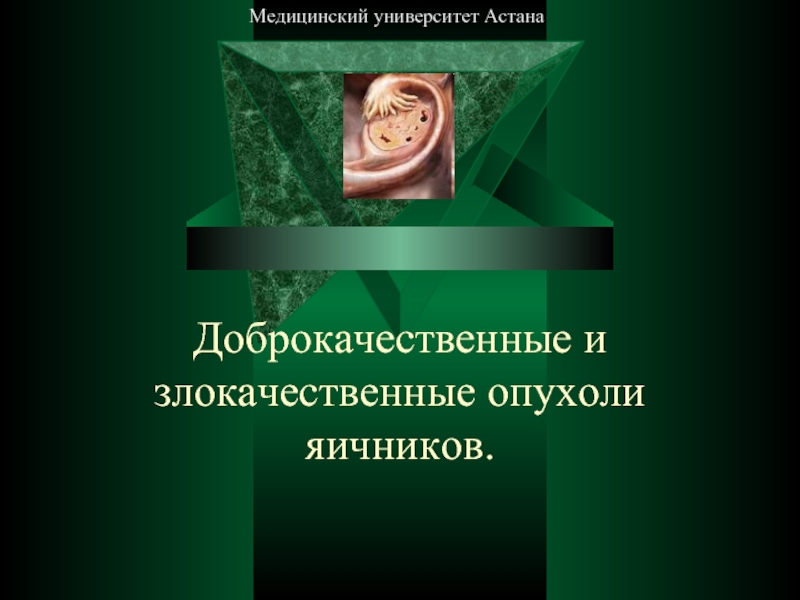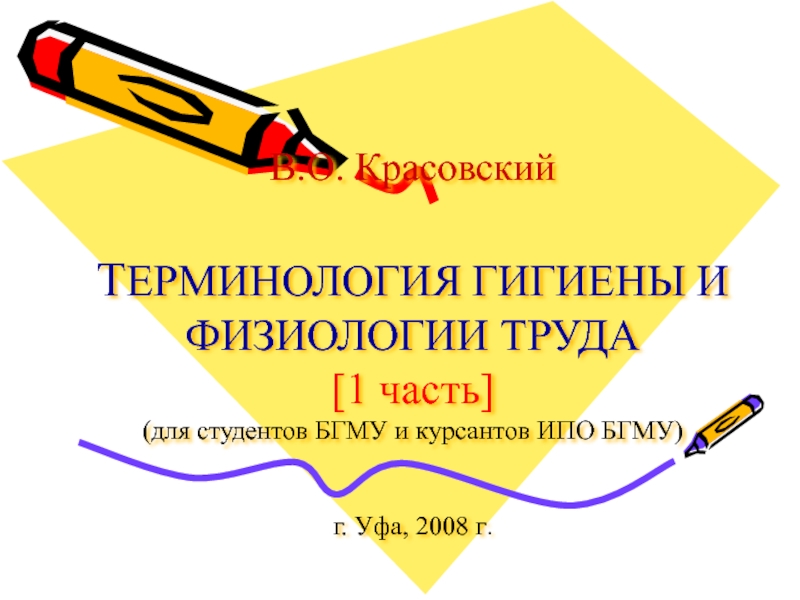- Главная
- Разное
- Дизайн
- Бизнес и предпринимательство
- Аналитика
- Образование
- Развлечения
- Красота и здоровье
- Финансы
- Государство
- Путешествия
- Спорт
- Недвижимость
- Армия
- Графика
- Культурология
- Еда и кулинария
- Лингвистика
- Английский язык
- Астрономия
- Алгебра
- Биология
- География
- Детские презентации
- Информатика
- История
- Литература
- Маркетинг
- Математика
- Медицина
- Менеджмент
- Музыка
- МХК
- Немецкий язык
- ОБЖ
- Обществознание
- Окружающий мир
- Педагогика
- Русский язык
- Технология
- Физика
- Философия
- Химия
- Шаблоны, картинки для презентаций
- Экология
- Экономика
- Юриспруденция
Efferent peripheral NS: the autonomic votor divisions презентация
Содержание
- 1. Efferent peripheral NS: the autonomic votor divisions
- 2. Autonomic nervous system: A part of
- 3. Review (again)
- 4. Autonomic Nervous System Responsible for control
- 6. Overview: The Parts of a Reflex
- 7. Autonomic Targets Smooth Muscle Cardiac Muscle Exocrine Glands Some Endocrine glands Lymphoid Tissue Adipose
- 8. Divisions of ANS Sympathetic Parasympathetic Metasympathetic
- 9. Sympathetic and parasympathetic divisions typically function
- 10. ANS 2 divisions: Sympathetic “Fight or
- 11. 1. The autonomic nervous system (ANS)
- 12. Autonomic pathway: Two Efferent Neurons in Series
- 14. 3. Although “involuntary”, the autonomic nervous
- 15. 4. The autonomic nervous system consists
- 16. Sympathetic “Fight or flight” “E” division Exercise, excitement, emergency, and embarrassment
- 17. = Thoracolumbar division (T1
- 18. Sympathetic (preganglionic ): 1. The cell bodies
- 19. Sympathetic (postganglionic ): 1. The cell bodies
- 20. Sympathetic ganglia Sympathetic chain ganglia (paravertebral
- 21. Sympathetic Trunk Ganglia Located on both sides
- 22. Prevertebral Ganglia Unpaired, not segmentally arranged Occur
- 23. The Organization of the Sympathetic Division of the ANS
- 24. Copyright Sympathetic Pathways to Periphery Figure 15.9
- 25. Rejoin spinal nerves and reach their destination
- 26. Copyright Sympathetic Pathways to Thoracic Organs
- 27. Sympathetic innervation via preganglionic fibers that synapse
- 28. Celiac ganglion Innervates stomach, liver, gall bladder,
- 29. Copyright Sympathetic Pathways to the Abdominal Organs
- 30. Copyright Sympathetic Pathways to the Pelvic Organs
- 31. Other important considerations: ganglion cells are usually
- 32. Sympathetic Division A single sympathetic preganglionic fiber
- 33. Sympathetic Variosities
- 34. Effects of Sympathetic Division cardiac output increases
- 35. THE STRESS REACTION A stressful situation activates
- 36. THE STRESS REACTION When stress occurs, the
- 38. The two divisions of
- 39. Homeostasis and the Autonomic Division BP, HR,
- 40. Other important considerations: ganglion cells are
- 41. The terminations of most, but not
- 43. The effects elicited by the action
- 44. Parasympathetic “Rest and digest” “D” division Digestion, defecation, and diuresis
- 45. Parasympathetic: Craniosacral or rest and digest Center
- 46. The Organization of the Parasympathetic Division of the ANS
- 47. The Distribution of Parasympathetic Innervation
- 49. = Craniosacral Division Long preganglionic axons
- 50. Parasympathetic: Craniosacral or rest and digest Center
- 51. The ganglion cells of the parasympathetic
- 53. Most postganglionic parasympathetic fibers release acetylcholine
- 54. Summary: Pre- & Postganglionic Parasympathetic Neurons Release ACh muscarinic nicotinic Receptors N1 N2
- 55. All parasympathetic fibers release ACh Short-lived response
- 56. Parasympathetic (muscarinic) cardiac output M2: decreases
- 57. Effects produced by the parasympathetic division relaxation food processing energy absorption Parasympathetic activation
- 58. The parasympathetic division controls body process
- 59. Most Common Autonomic NTs: Acetylcholine (ACh) ACh
- 60. NTs of Autonomic NS Compare to Fig
- 61. Neuroeffector Junction = Synapse between postganglionic cell
- 62. Summary: Pre- & Postganglionic Parasympathetic Neurons Release ACh muscarinic nicotinic Receptors N1 N2
- 63. Two Types of Cholinergic Receptors: Nicotinic and
- 64. When the neurotransmitter, acetylcholine, attaches to
- 65. 2) Muscarinic
- 66. Muscarinic ACh are G-protein Mediated Receptor Mechanism of Sweat Glands: Also some 2nd messenger mechanisms
- 67. Note on G-Proteins: Many functions of
- 68. Adrenergic Receptors Found in neuroeffector junctions
- 69. NE Action
- 70. Sympathetic Receptors α Receptors: NT
- 71. β − Receptors Clinically more important
- 72. Termination of NT Activity ACh: ACh esterase
- 73. Somatic Motor Division Pathway consists of single
- 74. Myasthenia gravis
- 75. Direct (Ant)agonist = mimic or block the
- 76. Strychnos Toxifera (Curare) from Koehler's Medicinal-Plants 1887
- 77. Indirect (Ant)agonists Botulinum toxin → inhibits
- 78. Important physiological and functional differences exist Comparison of the two divisions
- 79. Table 11-4 Overview: The ANS
- 80. Overview: The ANS Compare the somatic
- 81. A Comparison of Somatic and Autonomic Function
- 82. Summary of Efferent NS
- 84. Activity in the ANS is controlled by
- 85. Levels of Autonomic Control Example of
- 86. cc Limbic system ГИПОТАЛАМУС Craniosacral anterior nucleus posterior nucleus Thoracolumbar
- 88. Levels of Autonomic Control Example of
- 89. Visceral Afferents and Referred Pain
Слайд 2
Autonomic nervous system: A part of the nervous system that regulates
Слайд 4Autonomic Nervous System
Responsible for control of involuntary or visceral bodily
cardiovascular cardiovascular
respiratory respiratory
digestive digestive
urinary urinary
reproductive functions
Key role in the bodies response to stress
Слайд 7Autonomic Targets
Smooth Muscle
Cardiac Muscle
Exocrine Glands
Some Endocrine glands
Lymphoid Tissue
Adipose
Слайд 9
Sympathetic and parasympathetic divisions typically function in opposition to each other.
The sympathetic division typically functions in actions requiring quick responses.
The parasympathetic division functions with actions that do not require immediate reaction. Consider sympathetic as "fight or flight" and parasympathetic as "rest and digest".
Слайд 10ANS
2 divisions:
Sympathetic
“Fight or flight”
“E” division
Exercise, excitement, emergency, and embarrassment
Parasympathetic
“Rest
“D” division
Digestion, defecation, and diuresis
Слайд 11
1. The autonomic nervous system (ANS) is an involuntary motor (efferent)
2. Autonomic nerves are typically composed of a two-neuron chain. One neuron has its cell body in the central nervous system while the other is outside the CNS.
Слайд 12Autonomic pathway: Two Efferent Neurons in Series
Preganglionic neuron cell body in
Synapse in autonomic ganglion outside CNS (often divergence!)
Postganglionic neurons
target cells
N1
N2
Слайд 14
3. Although “involuntary”, the autonomic nervous system is regulated by higher
Слайд 15
4. The autonomic nervous system consists of two divisions:
a) the sympathetic
b) the parasympathetic (or craniosacral) division in which the preganglionic neurons are located in the brain stem and in sacral (S2 - S4) segments of the spinal cord.
Слайд 16Sympathetic
“Fight or flight”
“E” division
Exercise, excitement, emergency, and embarrassment
Слайд 17= Thoracolumbar
division (T1 to L2)
Preganglionic neurons
Pre and paravertebral ganglia
Long postganglionic neurins (N2) secrete NE onto adrenergic receptors
Слайд 18Sympathetic (preganglionic ):
1. The cell bodies giving rise to preganglionic neurons
2. Preganglionic fibers leave the spinal cord with the ventral roots of spinal nerves arising from cord segments T1 - L2.
Слайд 19Sympathetic (postganglionic ):
1. The cell bodies giving rise to postganglionic neurons
2. Prevertebral (collateral) ganglia: celiac, superior mesenteric, inferior mesenteric, aorticorenal and renal.
.
Слайд 20Sympathetic ganglia
Sympathetic chain ganglia (paravertebral ganglia) – preganglionic fibers of
Collateral ganglia (prevertebral ganglia) – group of second order neurons that innervate organs in the abdominopelvic region
Слайд 21Sympathetic Trunk Ganglia
Located on both sides of the vertebral column
Linked by
Joined to ventral rami by white and gray rami communicantes
Right and left sympathetic trunks extend from the base of the skull to the region of the coccyx; at their distal ends, the right and left trunks are fused.
Слайд 22Prevertebral Ganglia
Unpaired, not segmentally arranged
Occur only in abdomen and pelvis
Lie anterior
Main ganglia
Celiac, superior mesenteric, inferior mesenteric, inferior hypogastric ganglia
Слайд 25Rejoin spinal nerves and reach their destination by way of the
Those targeting structures in the thoracic cavity form sympathetic nerves
Go directly to their destination
Postganglionic fibers
Слайд 27Sympathetic innervation via preganglionic fibers that synapse within collateral ganglia
Splanchic nerves
Abdominopelvic viscera
Слайд 28Celiac ganglion
Innervates stomach, liver, gall bladder, pancreas, spleen
Superior mesenteric ganglion
Innervates small
Inferior mesenteric ganglion
Innervates kidney, urinary bladder, sex organs, and final portion of large intestine
Abdominopelvic viscera
Слайд 31Other important considerations:
ganglion cells are usually located at some distance from
Acetylcholine (Ach) - pre-ganglionic ganglionic Neurotransmitter
Norepinephrine (NE) - post-ganglionic ganglionic Neurotransmitter
Слайд 32Sympathetic Division
A single sympathetic preganglionic fiber has many axon collaterals and
The postganglionic axons typically terminate in several visceral effectors and therefore the effects of sympathetic stimulation are more widespread than the effects of parasympathetic stimulation.
Слайд 34Effects of Sympathetic Division
cardiac output increases
SA node: heart rate (chronotropic) β1,
vascular smooth muscle: α = contracts; β2 = relaxes
smooth muscles of bronchioles β2: relaxes;
pupil of eye α1: relaxes
ciliary muscle β2 : relaxes
smooth muscles of GI tractα, β2: relaxes
sphincters of GI tract α1: contracts
glands of GI tract inhibits
Слайд 35THE STRESS REACTION
A stressful situation activates three major communication systems in
The first of these systems is the voluntary nervous system, which sends messages to muscles so that we may respond to sensory information.
The second communication system is the autonomic nervous system.
The brain’s third major communication process is the neuroendocrine system, which also maintains the body’s internal functioning.
Слайд 36THE STRESS REACTION
When stress occurs, the sympathetic nervous system is triggered.
Acetylcholine is released in the parasympathetic nervous system, producing calming effects. The digestive tract is stimulated to digest a meal, the heart rate slows, and the pupils of the eyes become smaller. The neuroendocrine system also maintains the body’s normal internal functioning.
Слайд 38
The two divisions of the autonomic nervous system are
Слайд 39Homeostasis and the Autonomic Division
BP, HR, Resp., H2O balance, Temp. .
Mostly dual reciprocal innervation
i.e., agonist/antagonist or excitatory/inhibitory
Sympathetic:
AKA Thoracolumbar
flight-or-fight
Parasympathetic:
AKA Craniosacral
rest and digest
Слайд 40 Other important considerations:
ganglion cells are usually located at some distance
Слайд 41
The terminations of most, but not all, sympathetic postganglionic fibers release
Слайд 43
The effects elicited by the action of the sympathetic division of
Слайд 45Parasympathetic: Craniosacral or rest and digest Center of parasympathetic division the ANS
Has preganglionic cell bodies (N2) in the midbrain and brainstem and in sacral segments 2, 3 and 4 of the spinal cord.
The fibers of cells in the midbrain and brainstem are in the oculomotor (III), facial (VII), glossopharyngeal (IX), and vagus (X) nerves. They innervate smooth muscles of the eye (III), lacrimal and salivary glands (VII and IX), and smooth muscles of the thoracic and abdominal viscera (X).
Слайд 49= Craniosacral Division
Long preganglionic axons from brain & S2- S4
Postganglionic (nonmyelinated) neurons secrete ACh onto cholinergic muscarinic receptors
Слайд 50Parasympathetic: Craniosacral or rest and digest Center of parasympathetic division the ANS
The cell bodies giving rise to postganglionic neurons (N2) are located in the Intramural ganglia.
Слайд 51
The ganglion cells of the parasympathetic system are located in or
Except for the vagus nerves, the area of distribution of parasympathetic nerves is somewhat limited. The number of synaptic connections is smaller than in the sympathetic division. Accordingly, the effects of the parasympathetic division tend to be local rather than widespread.
Слайд 53
Most postganglionic parasympathetic fibers release acetylcholine at their terminations. These fibers
Слайд 54Summary: Pre- & Postganglionic Parasympathetic Neurons Release ACh
muscarinic
nicotinic
Receptors
N1
N2
Слайд 55All parasympathetic fibers release ACh
Short-lived response as ACH is broken down
Neurotransmitters and parasympathetic functions
Слайд 56Parasympathetic (muscarinic)
cardiac output M2: decreases
SA nodeSA node: heart rate (chronotropic)
cardiac musclecardiac muscle: contractility (inotropiccardiac muscle: contractility (inotropic) M2: decreases (atria only)
conduction at AV node M2: decreases
smooth musclessmooth muscles of bronchioles M3: contracts
pupilpupil of eye M3: contracts
ciliary muscle M3: contracts
salivary glands: secretions stimulates watery secretions
GI tract motility M1, M3: increases
smooth musclessmooth muscles of GI tract M3: contracts
sphincterssphincters of GI tract M3: relaxes
glandsglands of GI tract M3: secretes
Слайд 57Effects produced by the parasympathetic division
relaxation
food processing
energy absorption
Parasympathetic activation
Слайд 58
The parasympathetic division controls body process during ordinary situations. Generally, it
Слайд 59Most Common Autonomic NTs:
Acetylcholine (ACh)
ACh neurons & ACh receptors are called
Norepinephrine (NE)
NE neurons & receptors are called (nor) adrenergic (α and β). Located at sympathetic postganglionic synapses
Fig 11-7
Слайд 61Neuroeffector Junction
= Synapse between postganglionic cell and target
Most are different from
ANS synapse: axon has varicosities containing neurotransmitter
May supply many cells, resulting in less specific communication
Synthesis of NT is in the varicosity
Fig 11-8
Слайд 62Summary: Pre- & Postganglionic Parasympathetic Neurons Release ACh
muscarinic
nicotinic
Receptors
N1
N2
Слайд 63Two Types of Cholinergic Receptors: Nicotinic and Muscarinic
Nicotine = agonist
In autonomic
Directly opens a Na+ & K+ channel: ⇒ ?
Curare = antagonist
1) Nicotinic cholinergic receptor
Слайд 64
When the neurotransmitter, acetylcholine, attaches to the portion of the nicotinic
Слайд 652) Muscarinic
Muscarine = agonist
Found in neuro-effector junctions of parasympathetic branch
G-protein coupled mechanisms
Atropine = antagonist
Amanita muscarina
N1
N2
Слайд 66Muscarinic ACh are G-protein Mediated Receptor Mechanism of Sweat Glands:
Also some
Слайд 67Note on G-Proteins:
Many functions of the nervous system (e.g., memory)
Слайд 68Adrenergic
Receptors
Found in neuroeffector junctions of sympathetic branch
G protein linked, with
NT is NE
α- and β- Receptors
Слайд 70Sympathetic Receptors
α Receptors:
NT is NE
(most common) ⇒ Excitation [Ca2+]
⇒ Inhibition of GI tract and pancreas
Слайд 71
β − Receptors Clinically more important
β1 ⇒ Excitation heart ([E]
“β - blockers” = Antagonists (e.g.: Propranolol)
β2 usually inhibitory: smooth muscle relaxation of some blood vessels and bronchioles ([E] > [NE])
β3 Adipose; [NE]>[E]
“β -blockers” = Antagonists (e.g.: Propranolol)
Слайд 72Termination of NT Activity
ACh:
ACh esterase
Catecholamine reuptake
repackaging
degradation (MAO)
Blocked by cocaine
Fig 11-9
Fig 8-22
Слайд 73Somatic Motor Division
Pathway consists of single neuron from CNS to target
Neuromuscular
Similar to synapse; post – synaptic membrant called Motor End Plate
Recall Motor Unit
Always excitatory ⇒ muscle contracts
All Ach mediated
Degraded by Ach esterase
Fig 11-13
Слайд 74
Myasthenia gravis
MG: Antibodies block, alter, or destroy the receptors for acetylcholine
Слайд 75Direct (Ant)agonist = mimic or block the NT receptor (Ant)agonist = mimic
Слайд 76Strychnos Toxifera (Curare) from Koehler's Medicinal-Plants 1887
Direct Antagonists
Atropine → muscarinic
Curare
Propranolol → β1 and β2
Metoprolol → β1
Слайд 77Indirect (Ant)agonists
Botulinum toxin
→ inhibits ACh release
Parathion, malathion
organophosphate insecticides → inhibit
Cocaine
→ prevents NE reuptake
Amphetamines
→ stimulates NE release
Слайд 80Overview: The ANS
Compare the somatic motor pathway to the parasympathetic
Слайд 84Activity in the ANS is controlled by centers in the brainstem
Higher levels of autonomic control
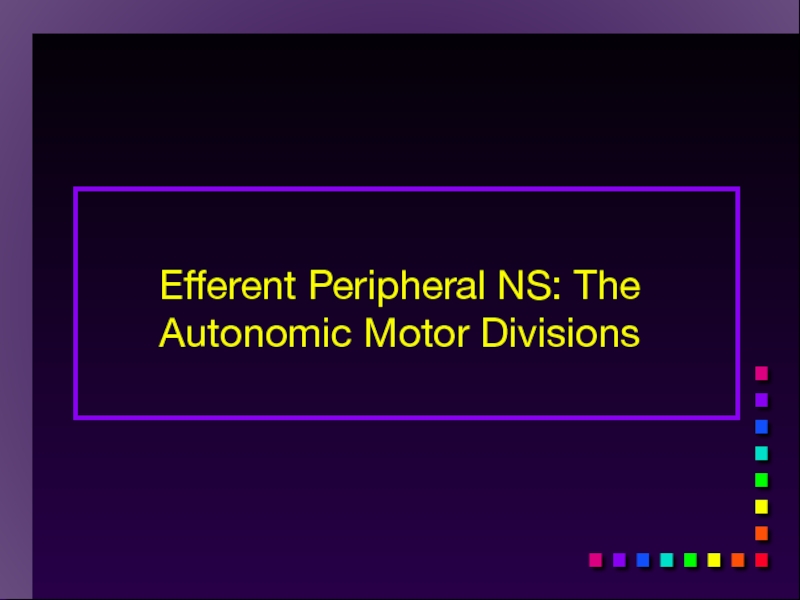
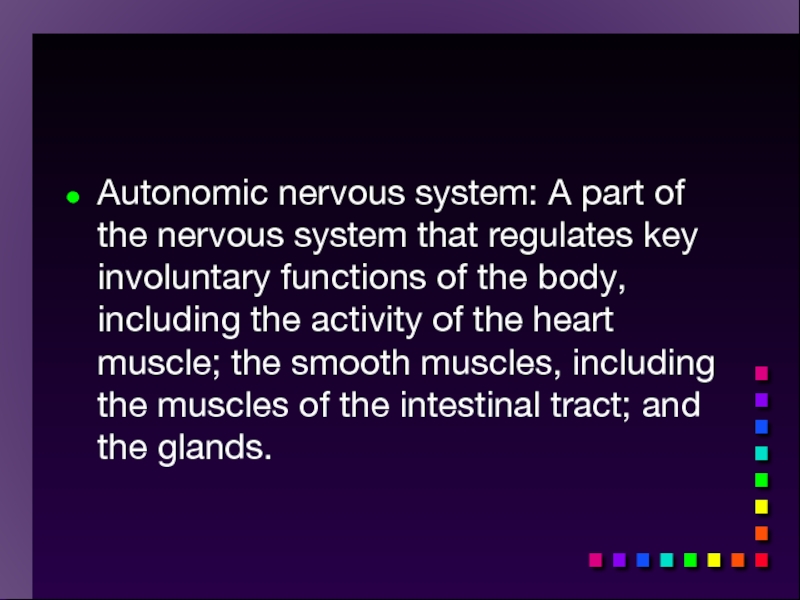

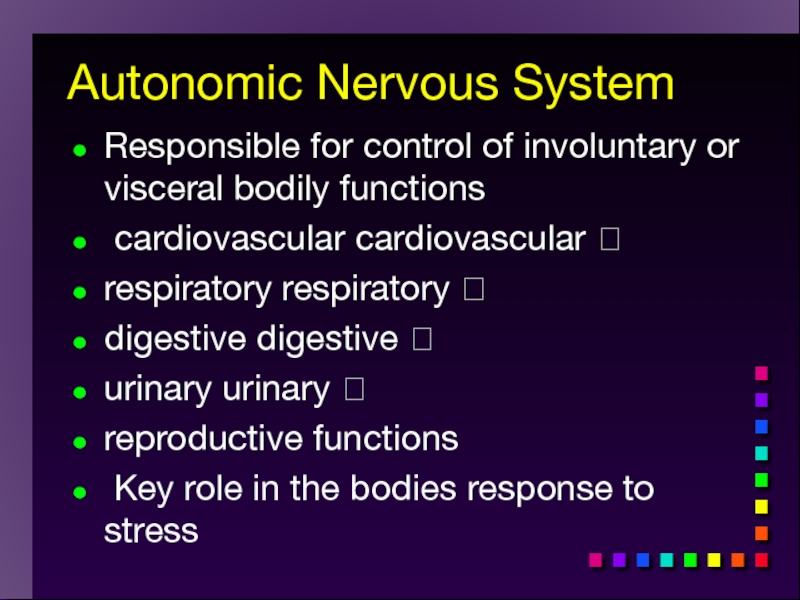
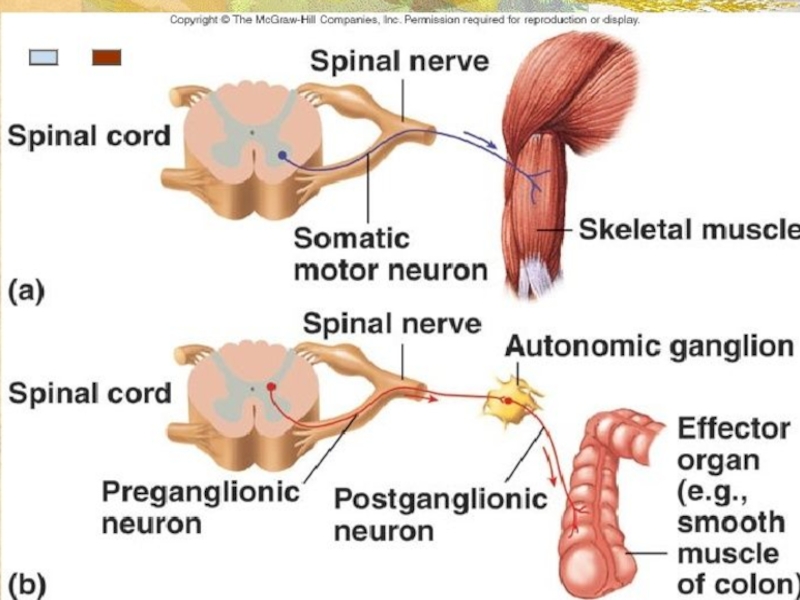
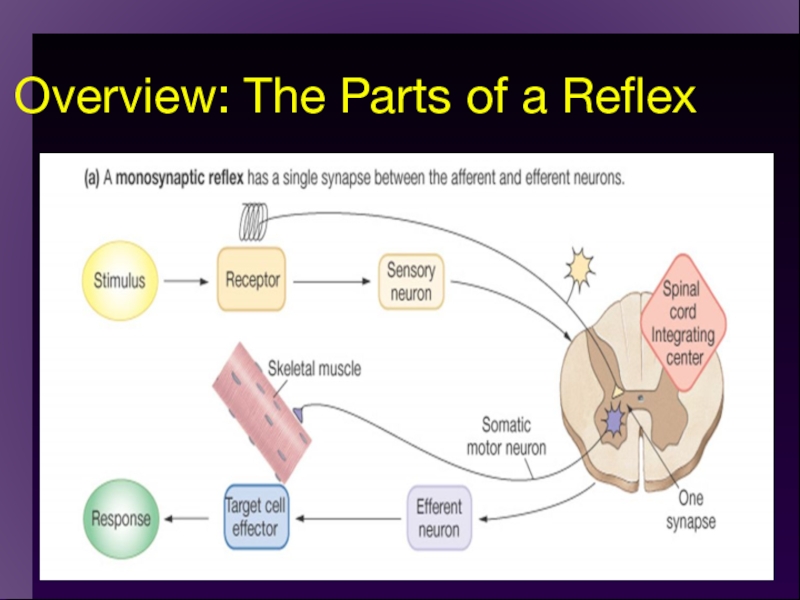
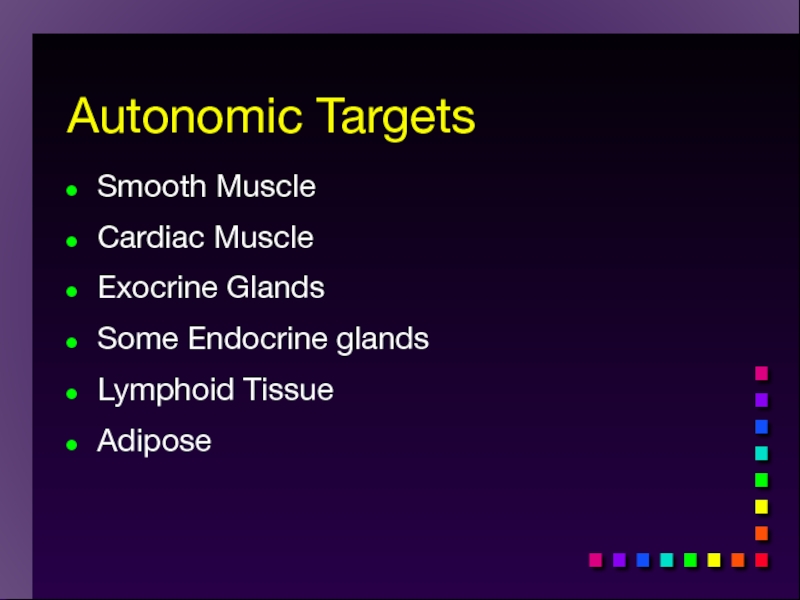
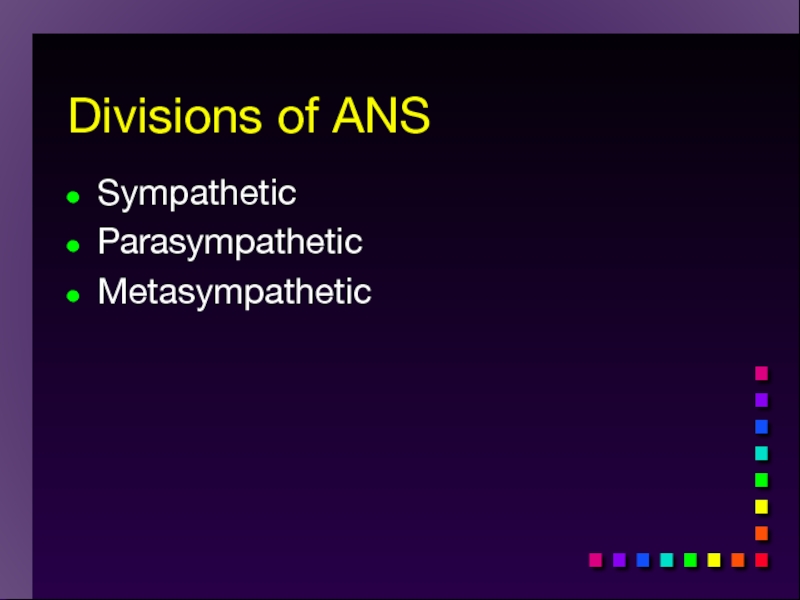
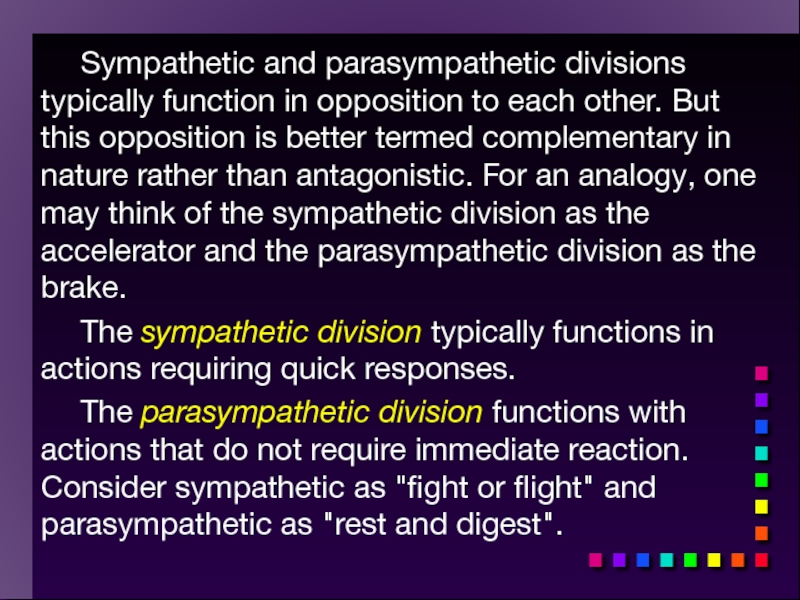
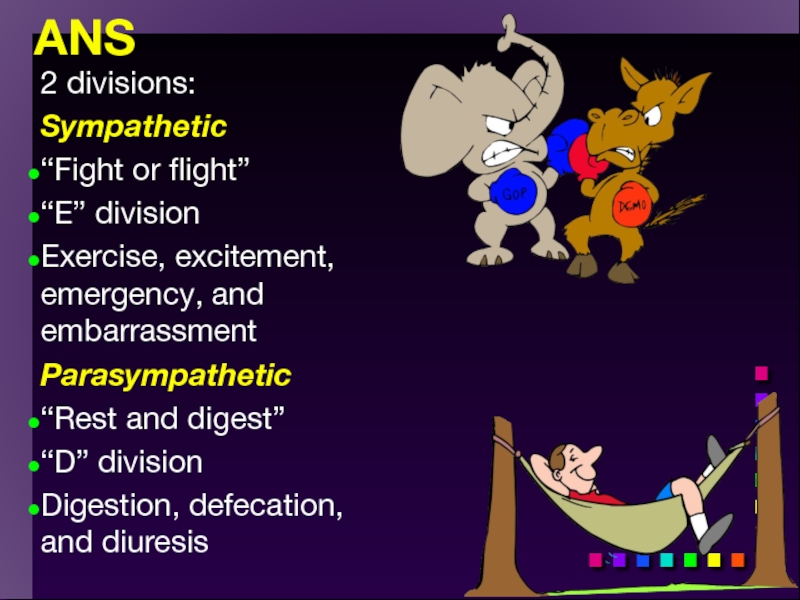
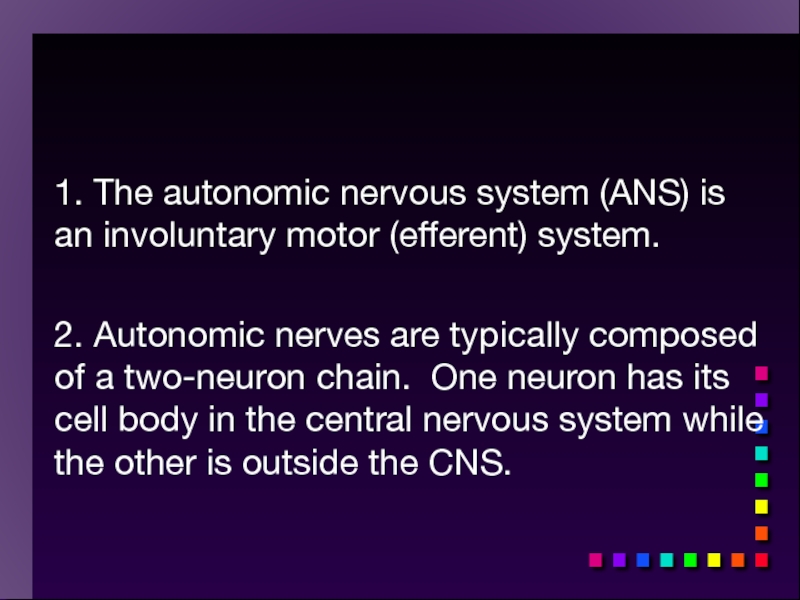
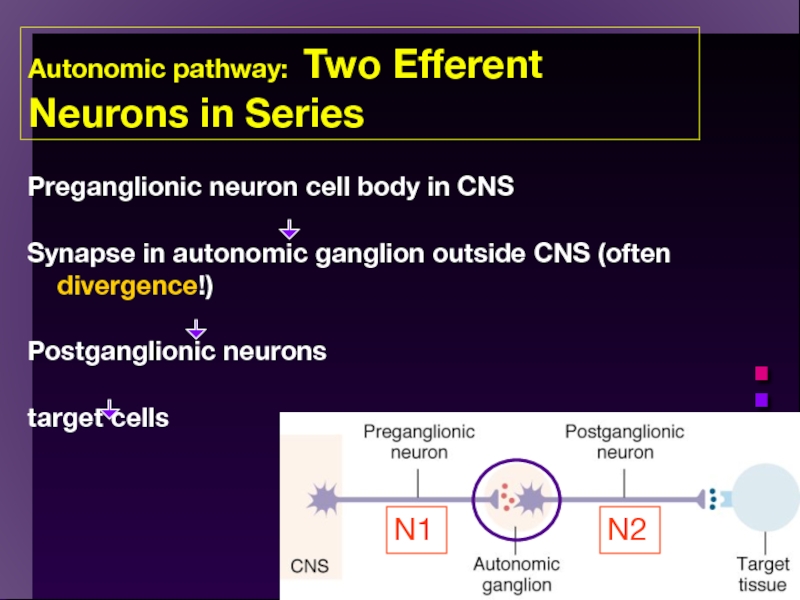
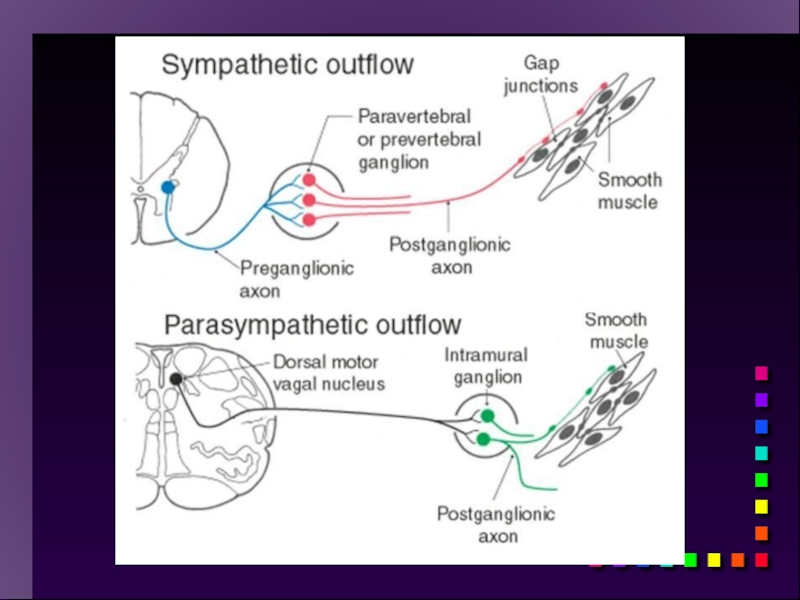
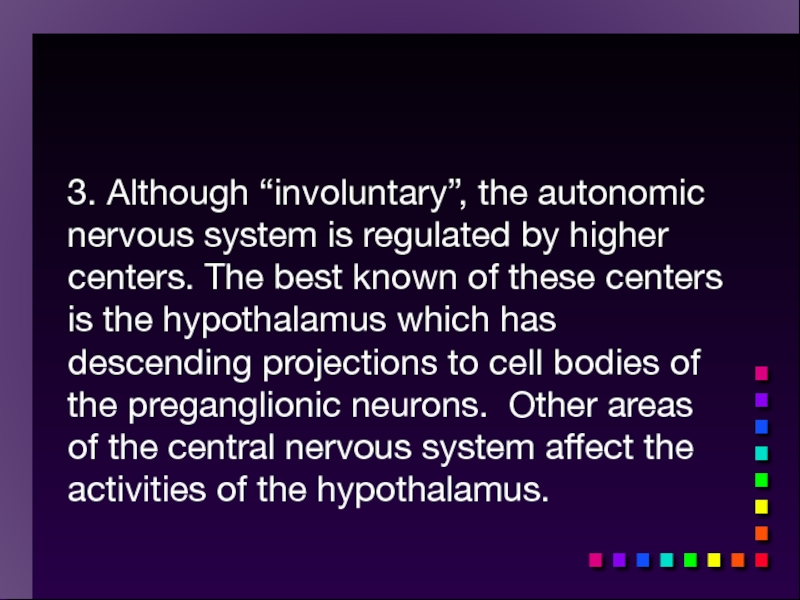
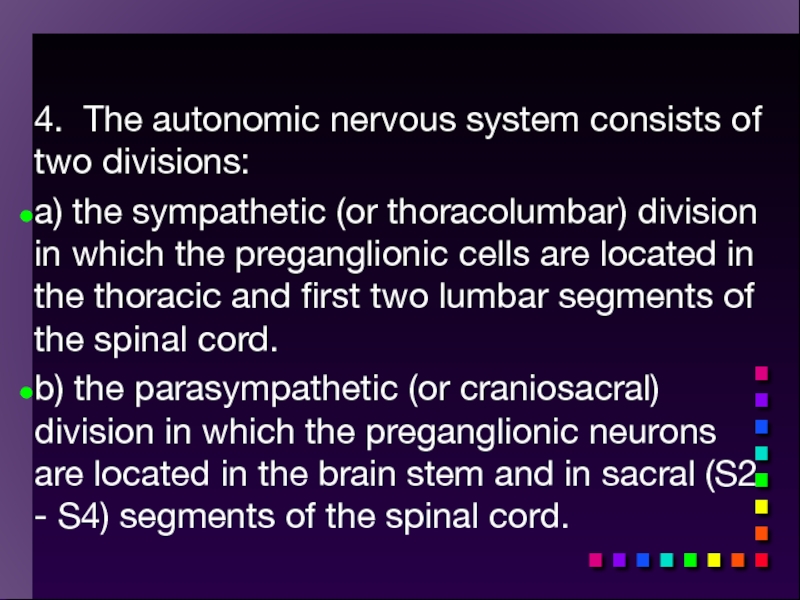
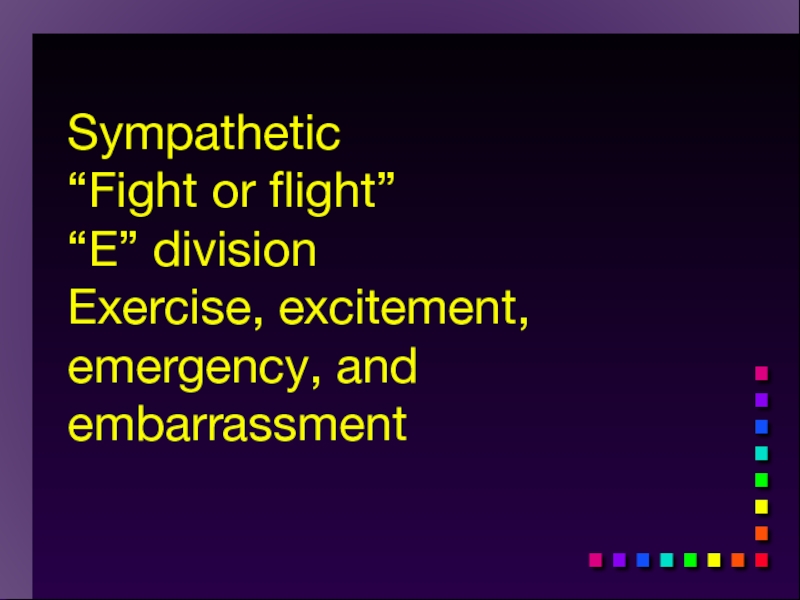
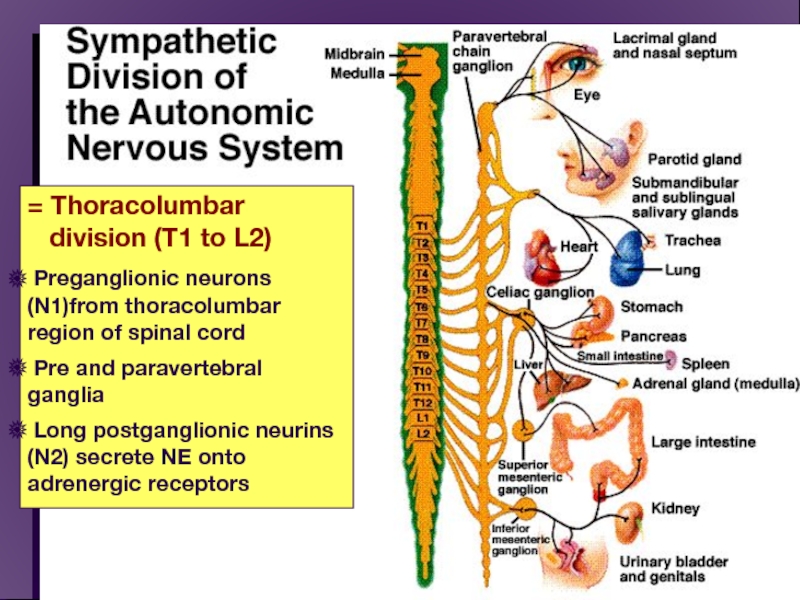
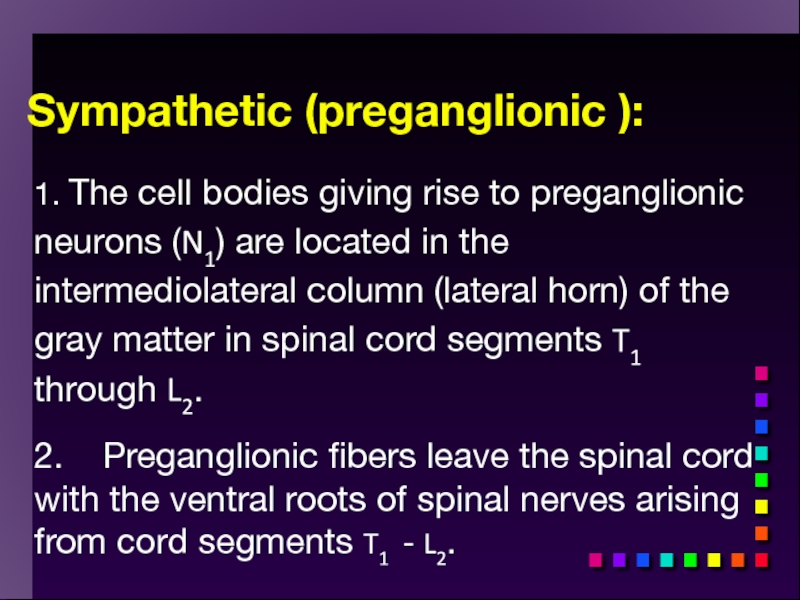
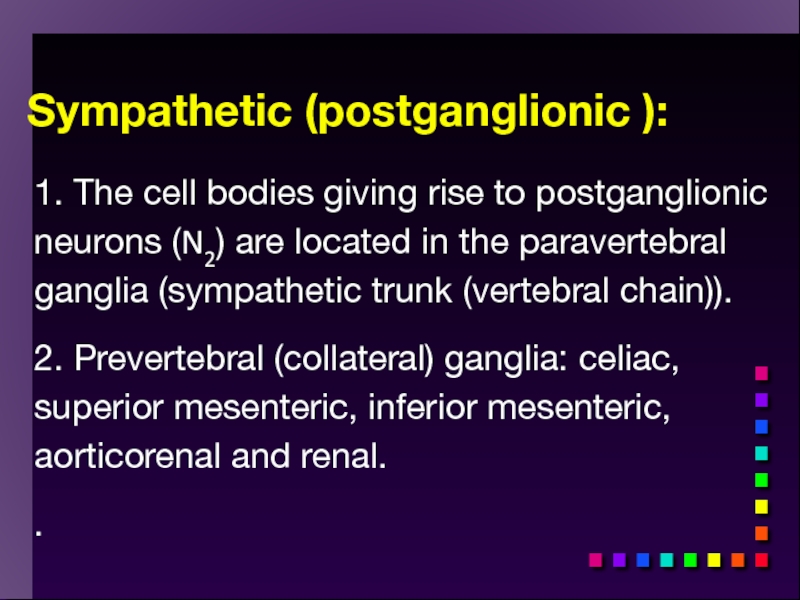
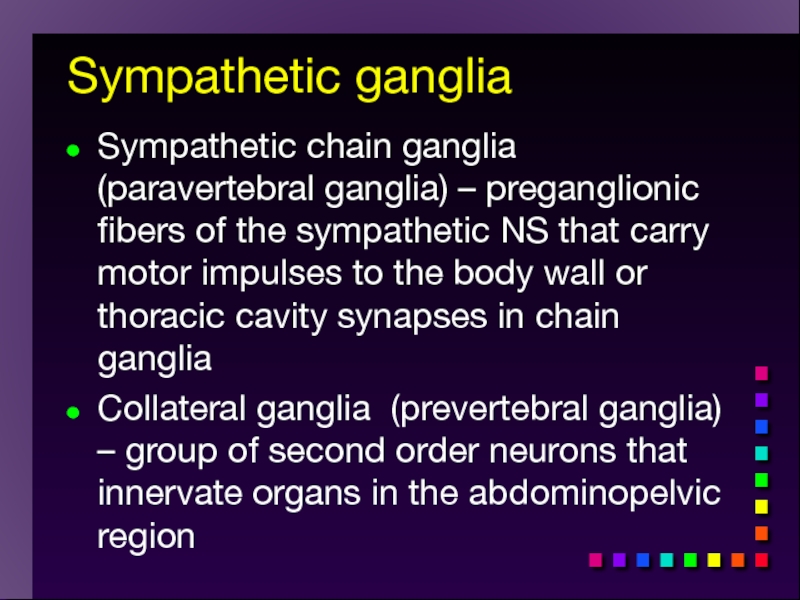
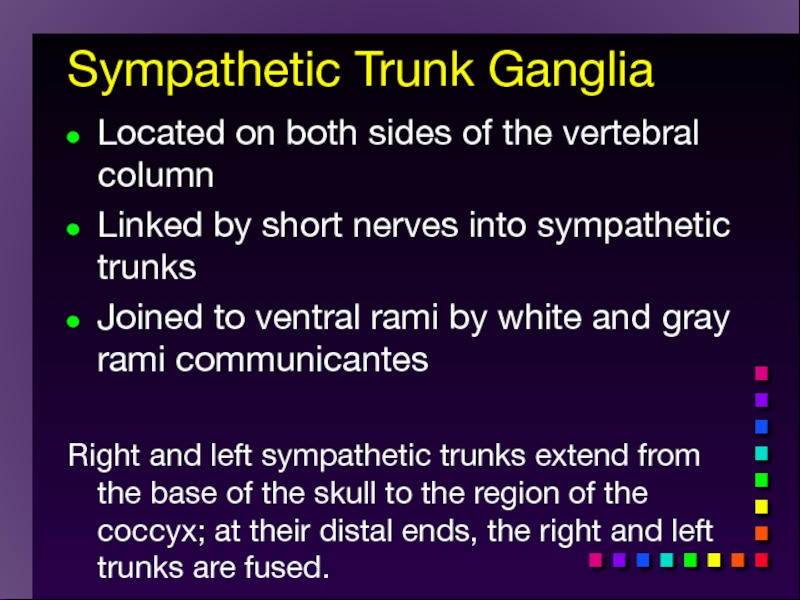

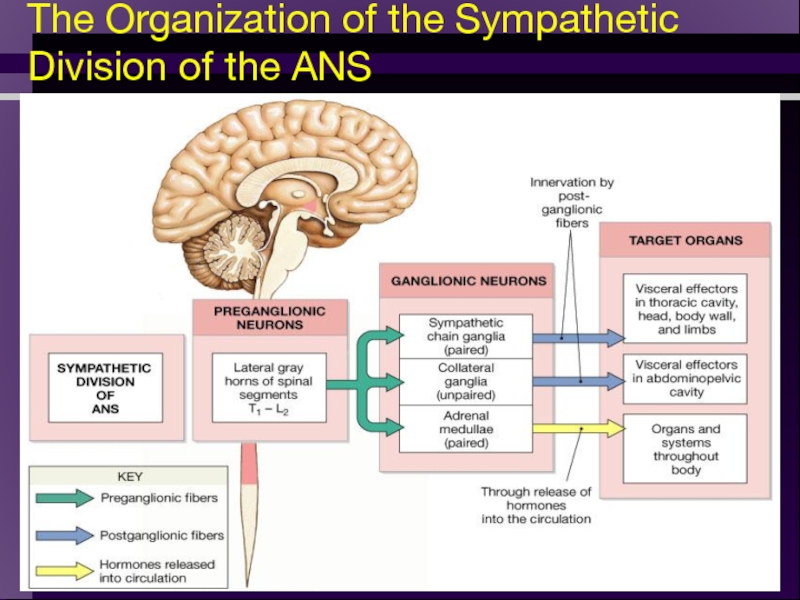
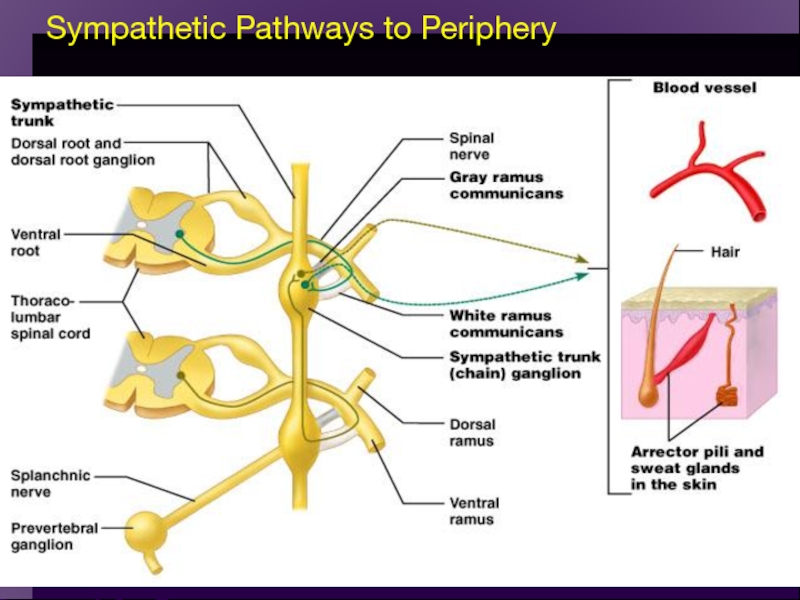
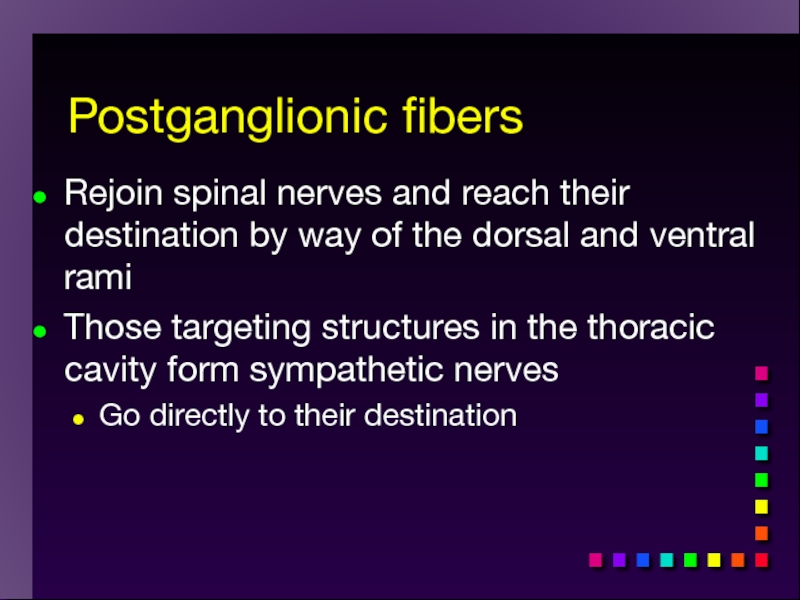
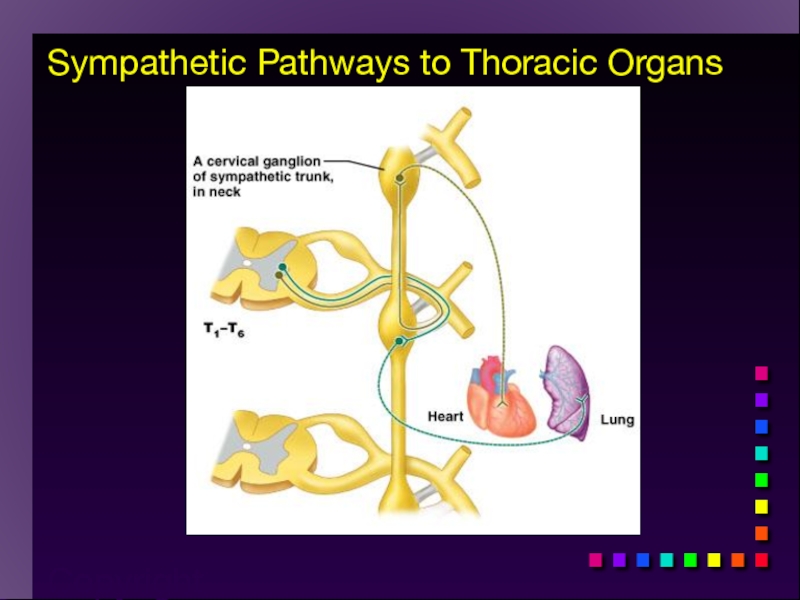
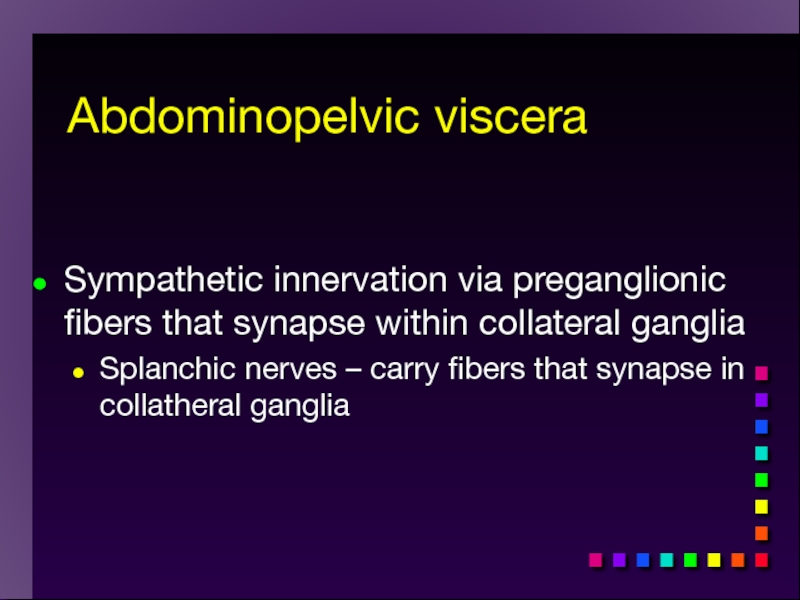
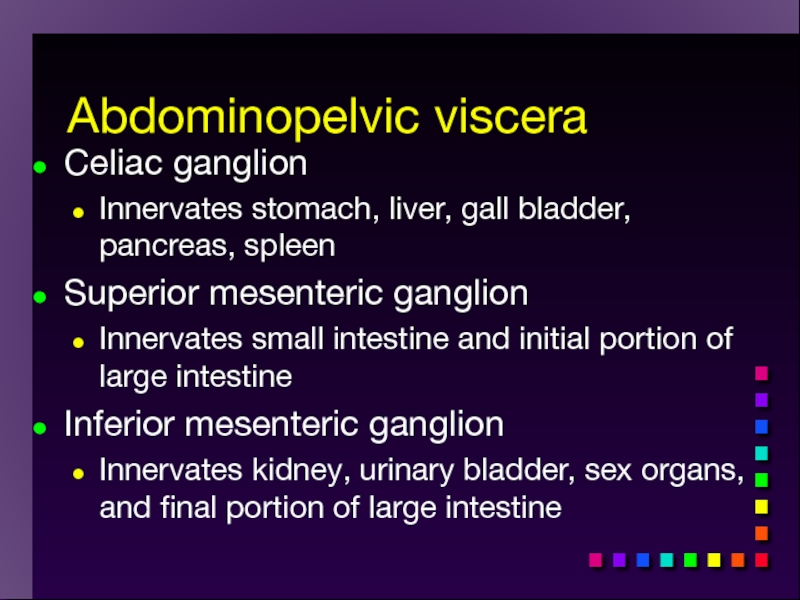
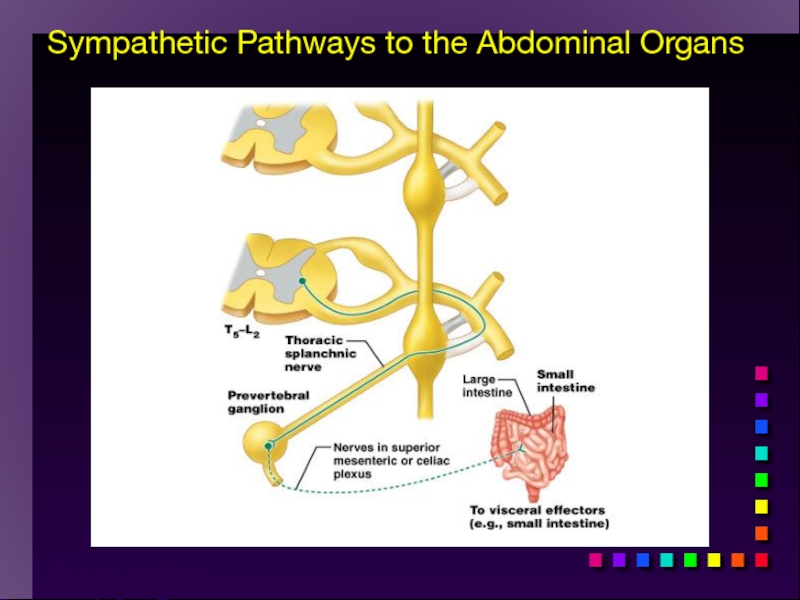
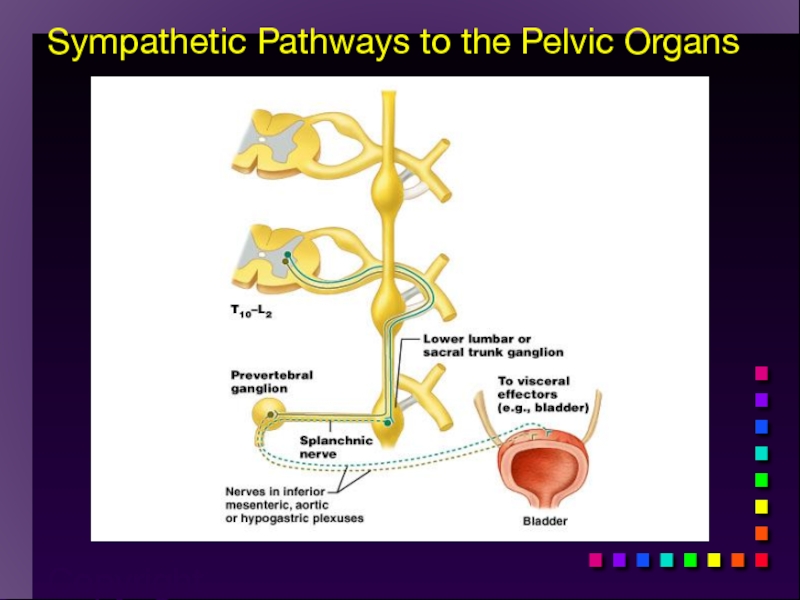
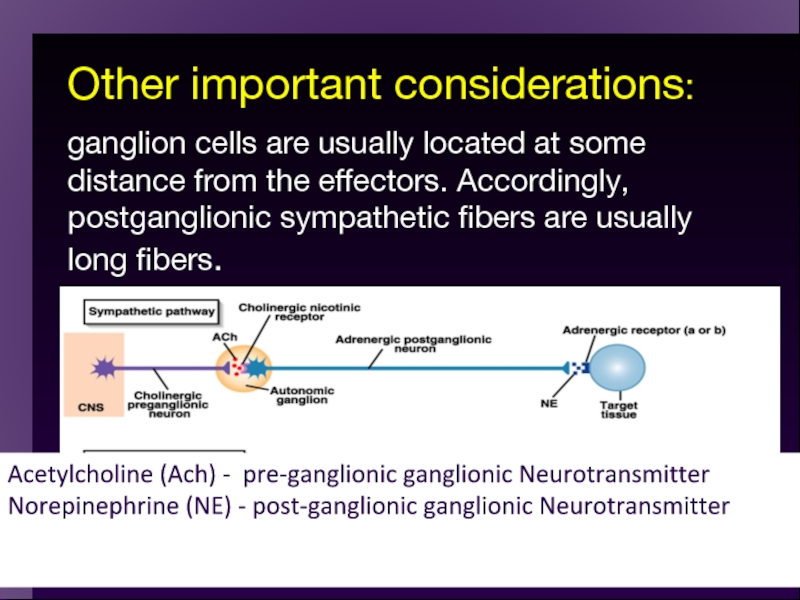
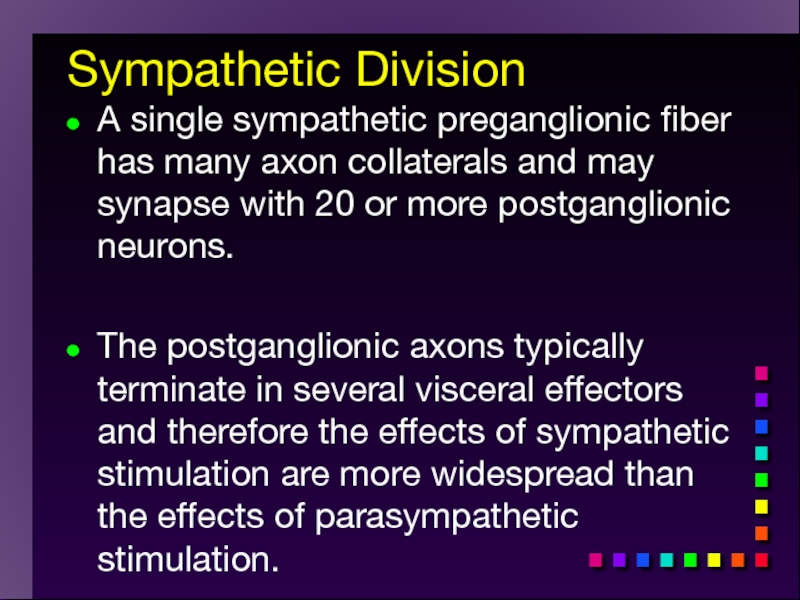
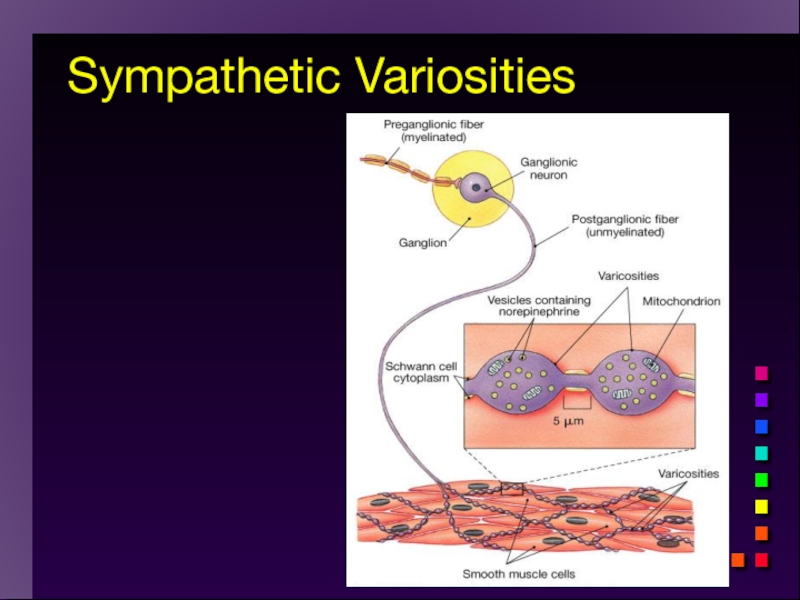
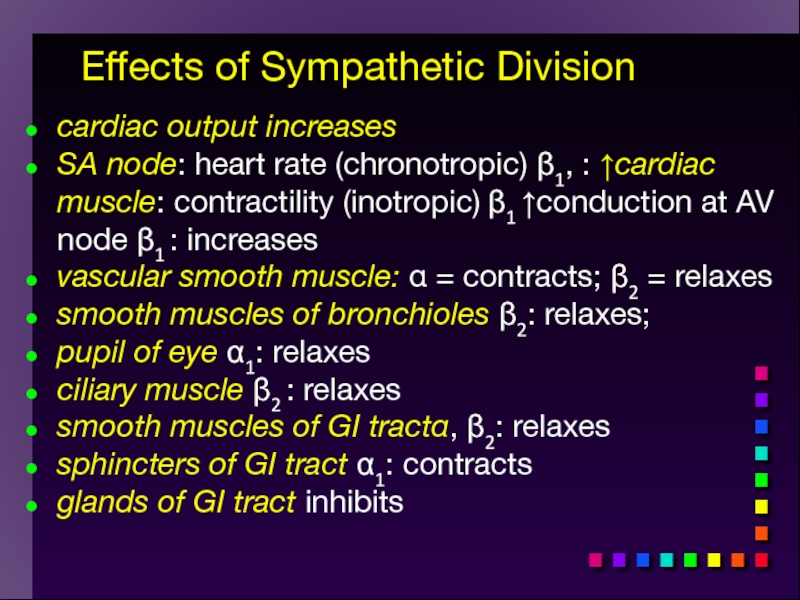
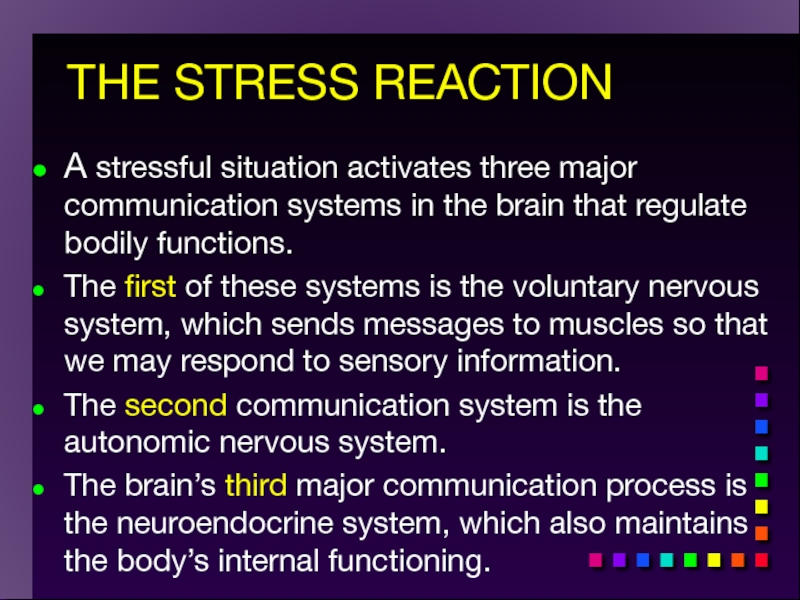

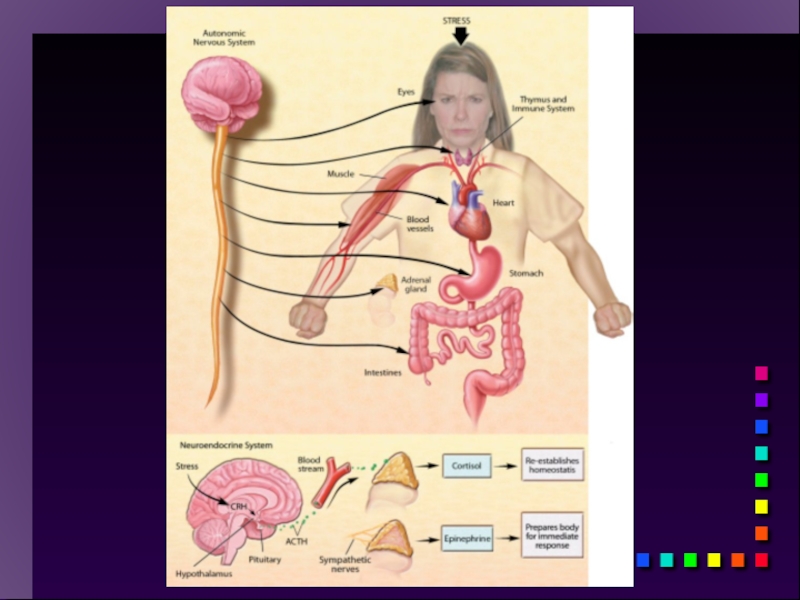
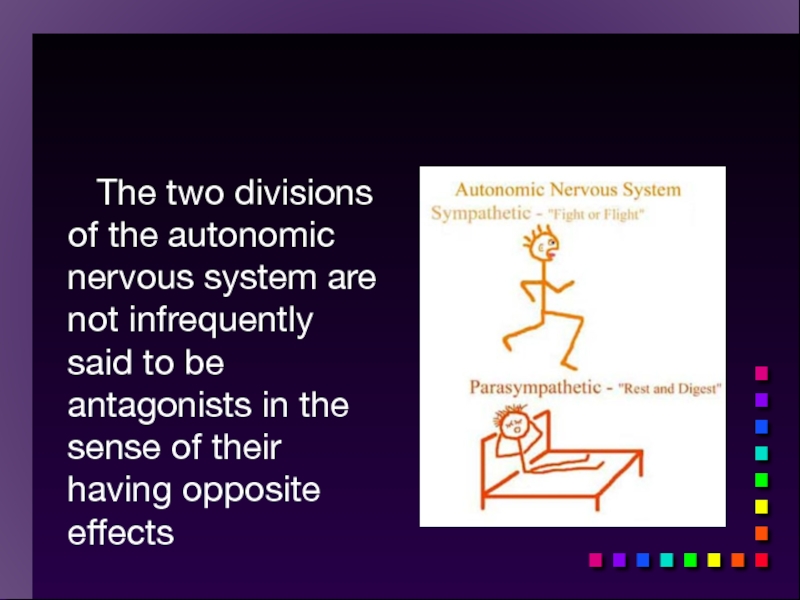
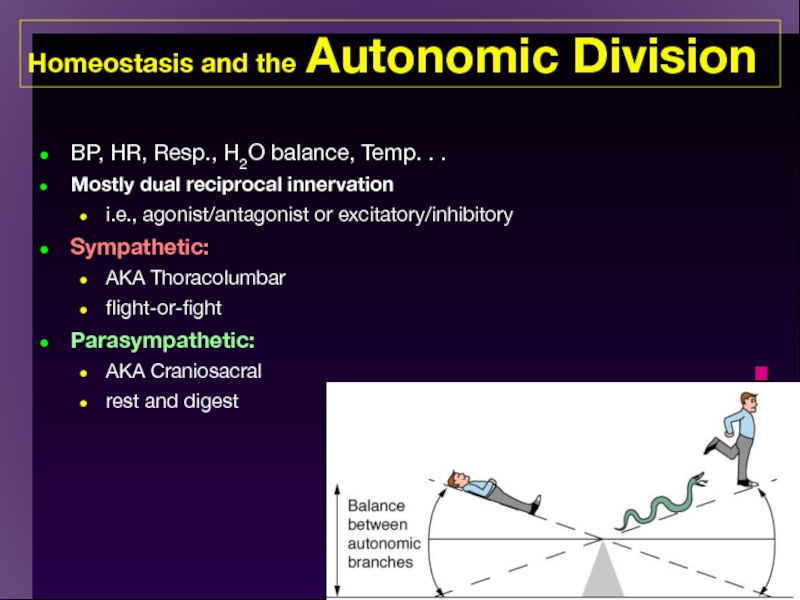
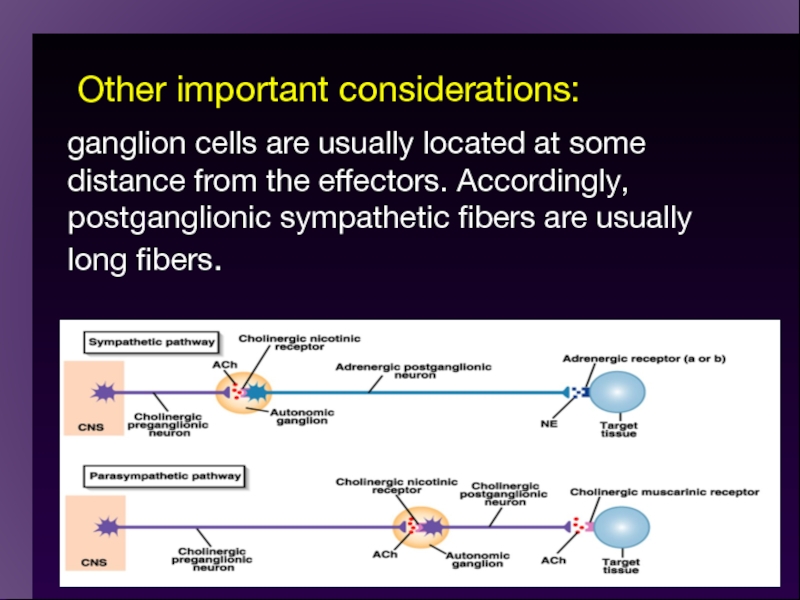
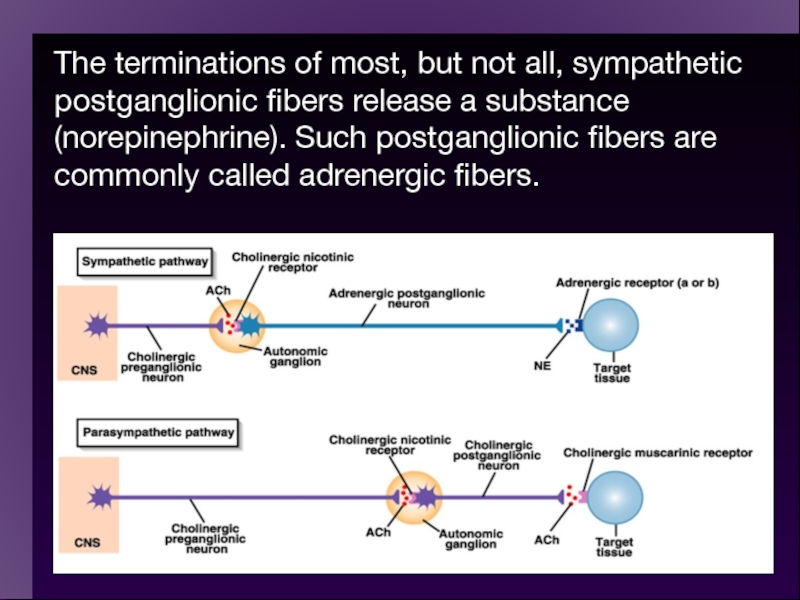
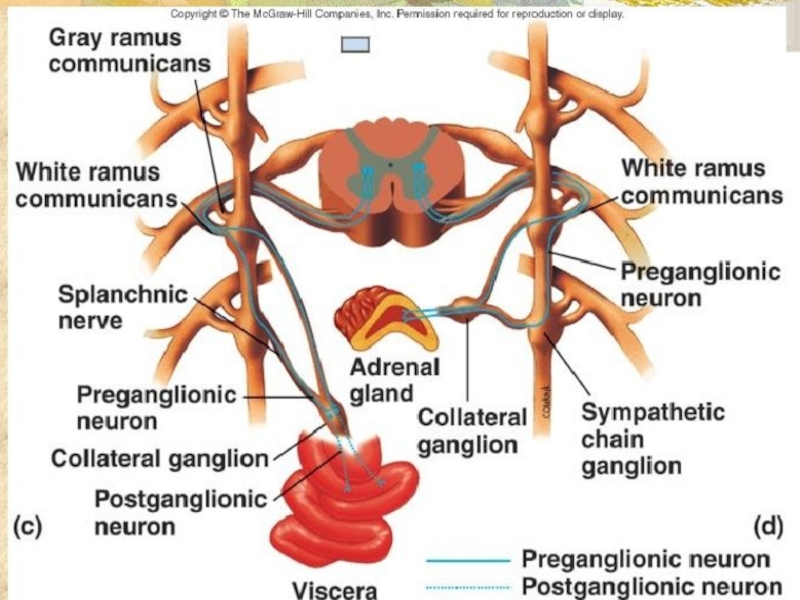
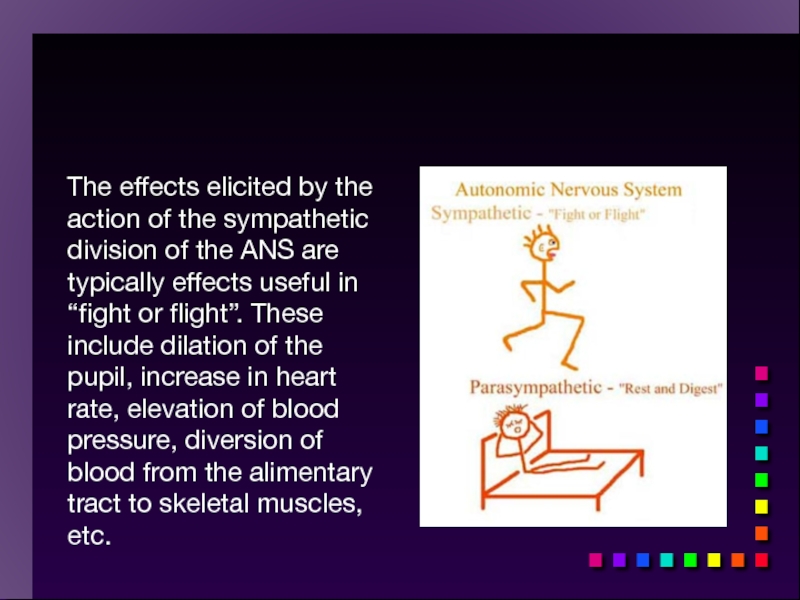
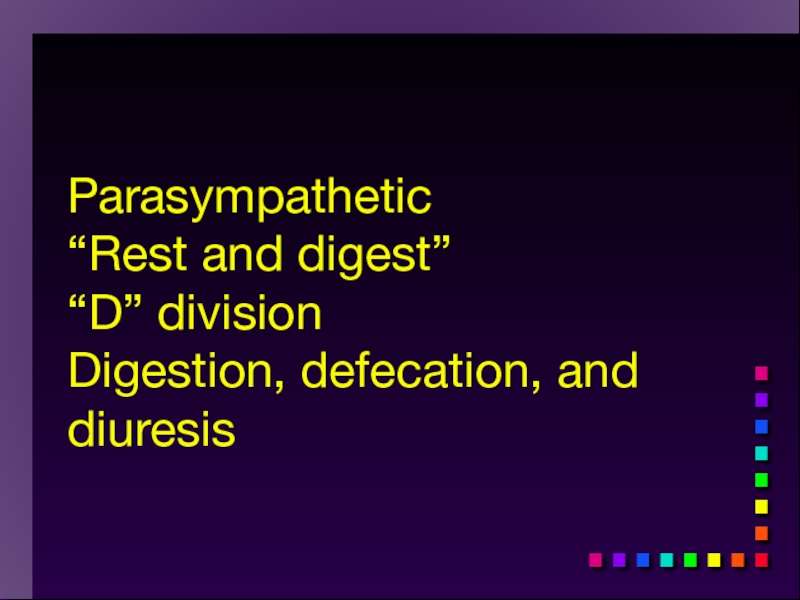
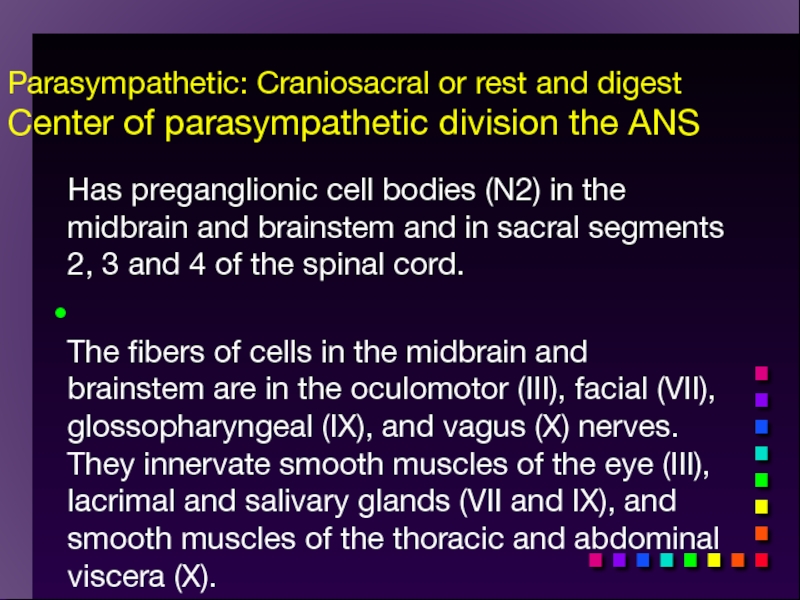
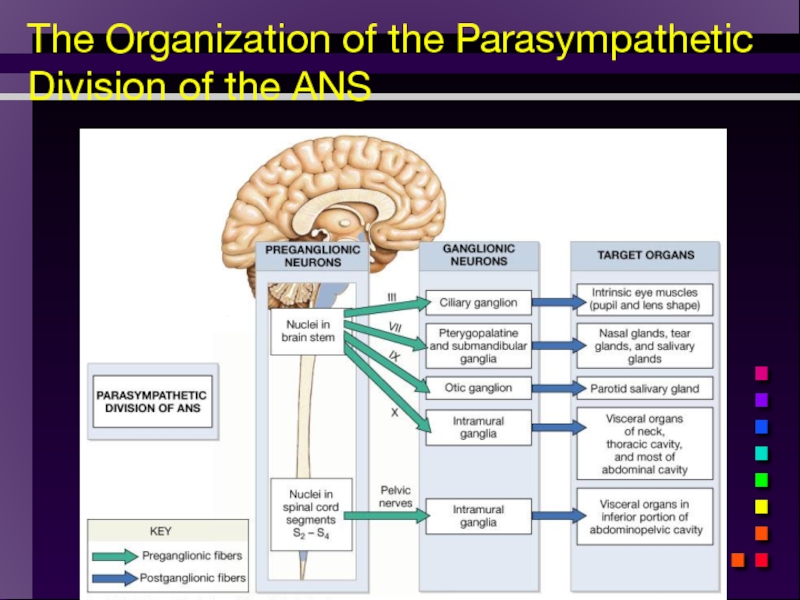
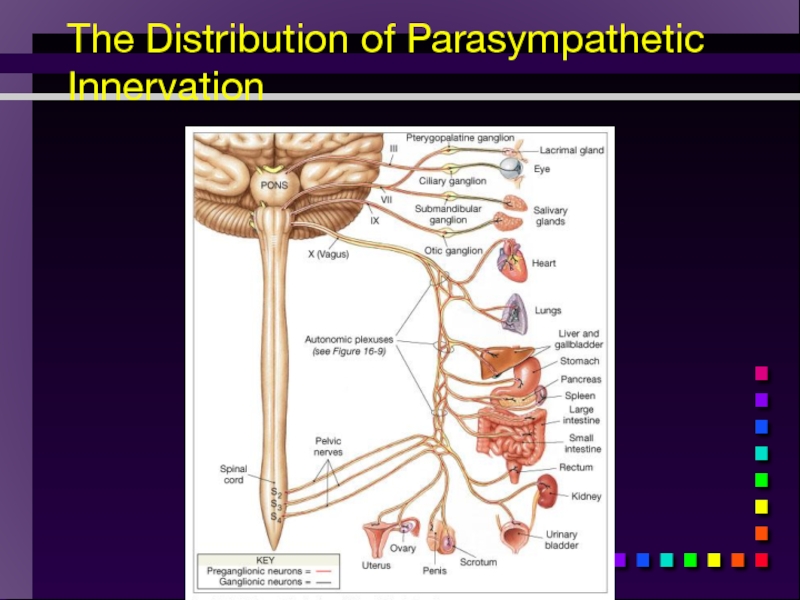
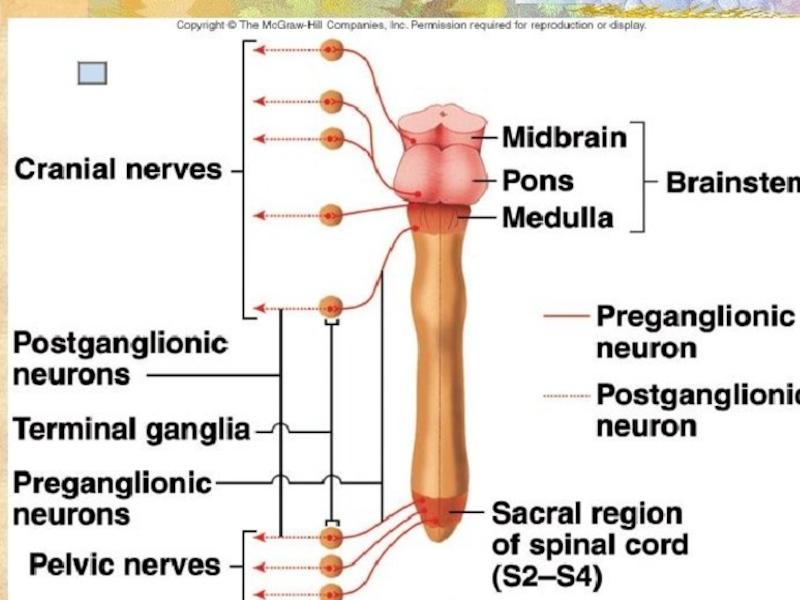
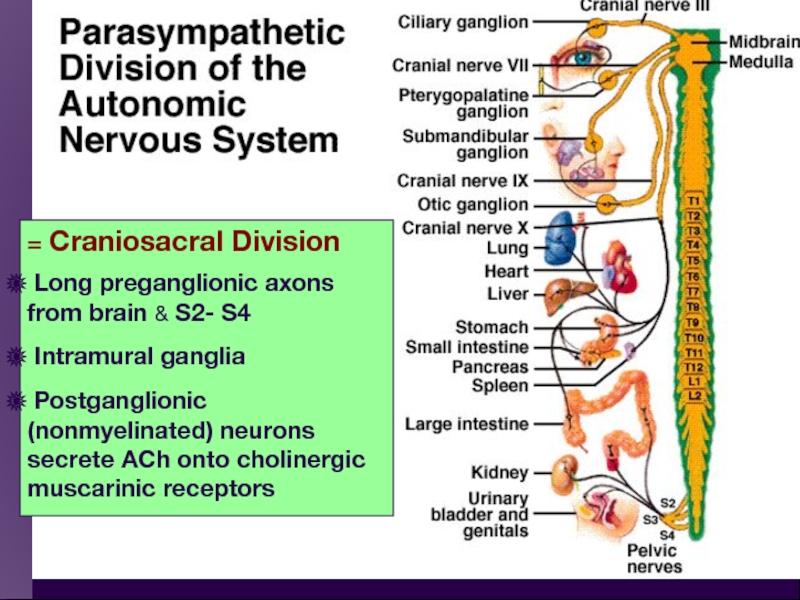
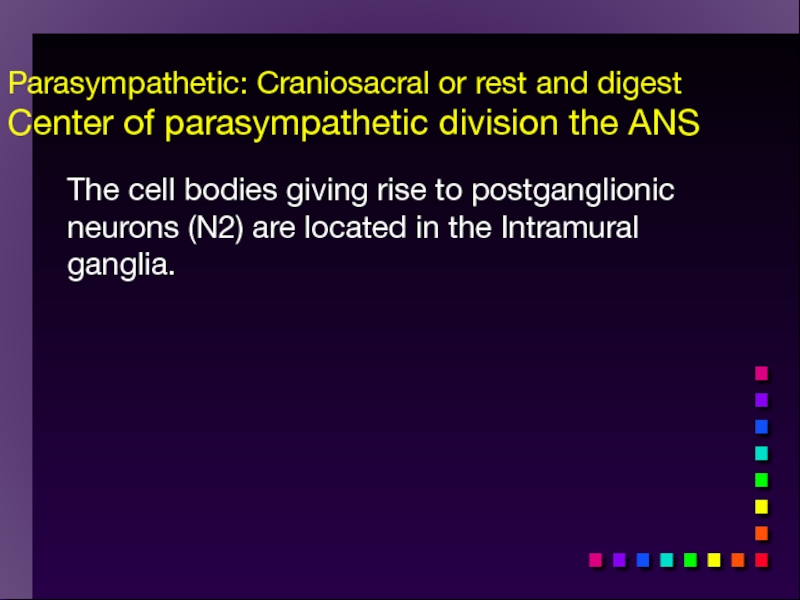
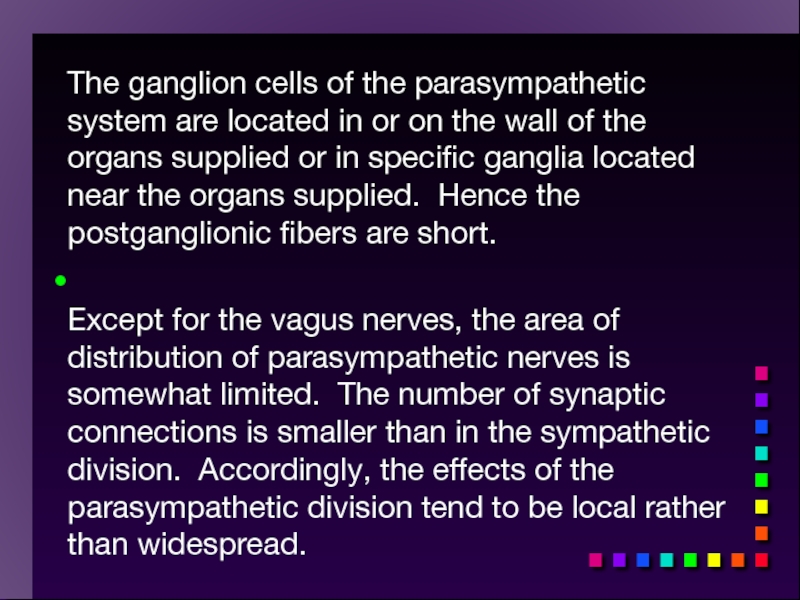
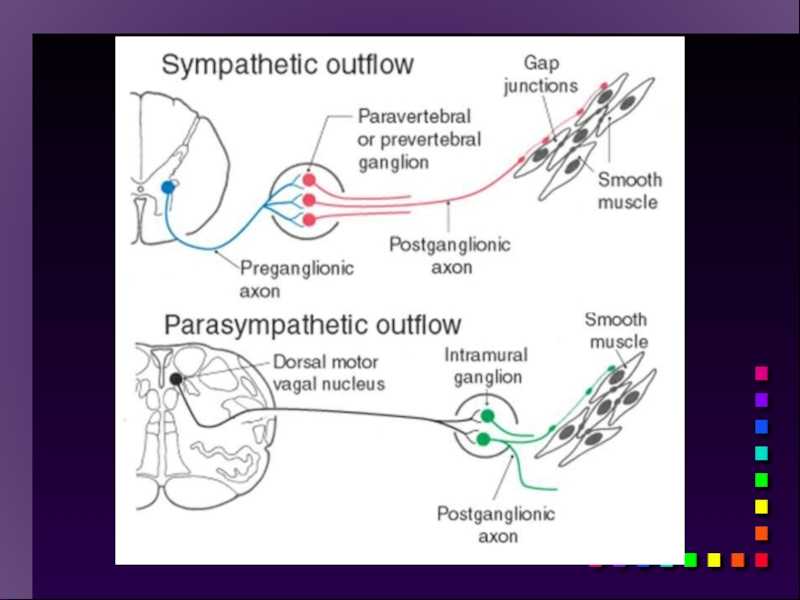
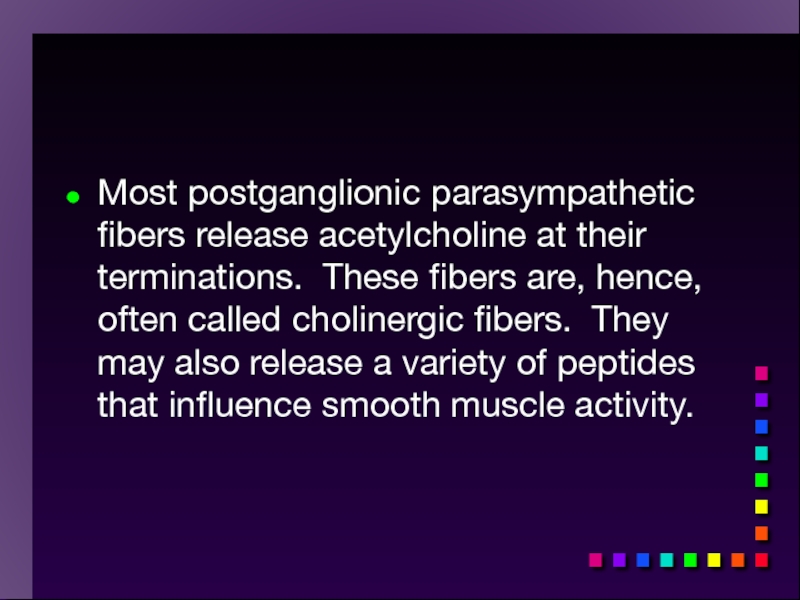
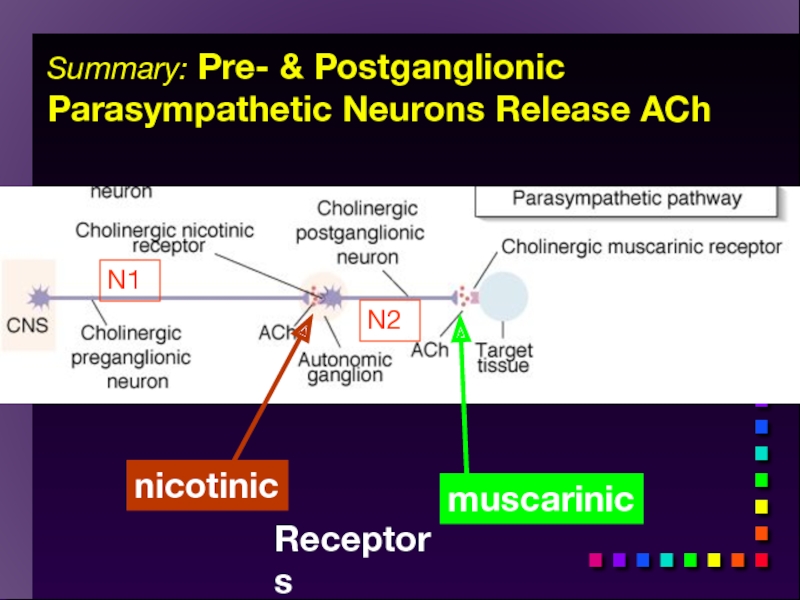
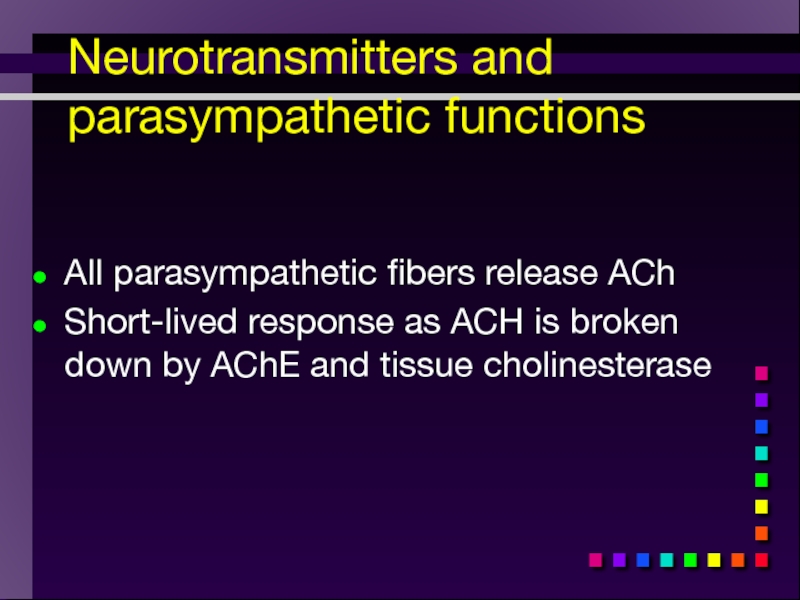
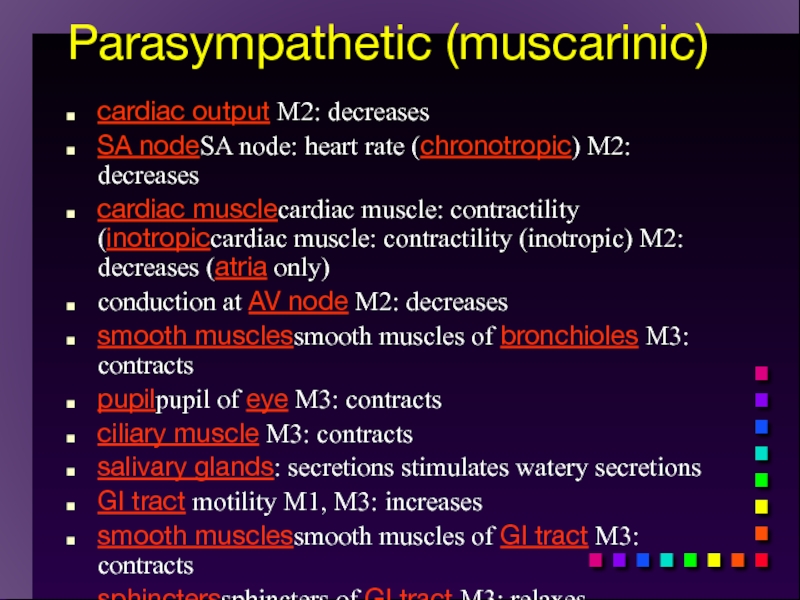
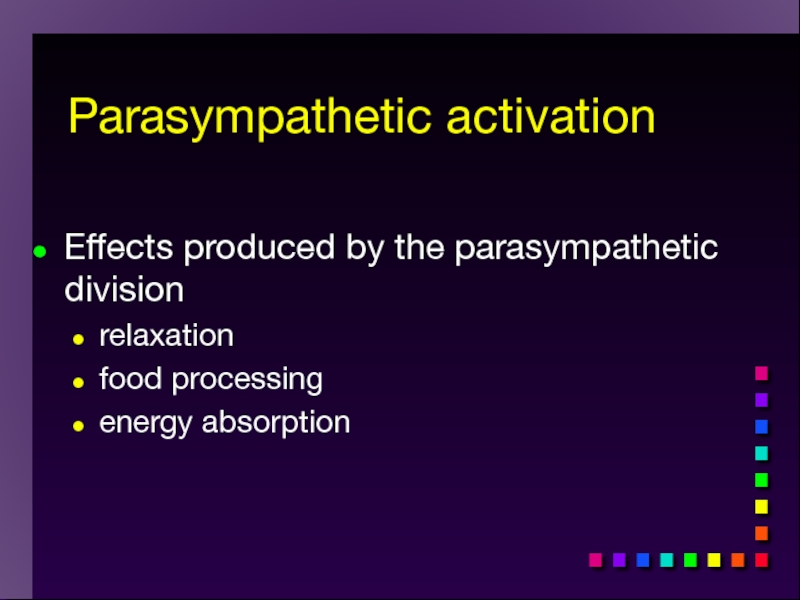

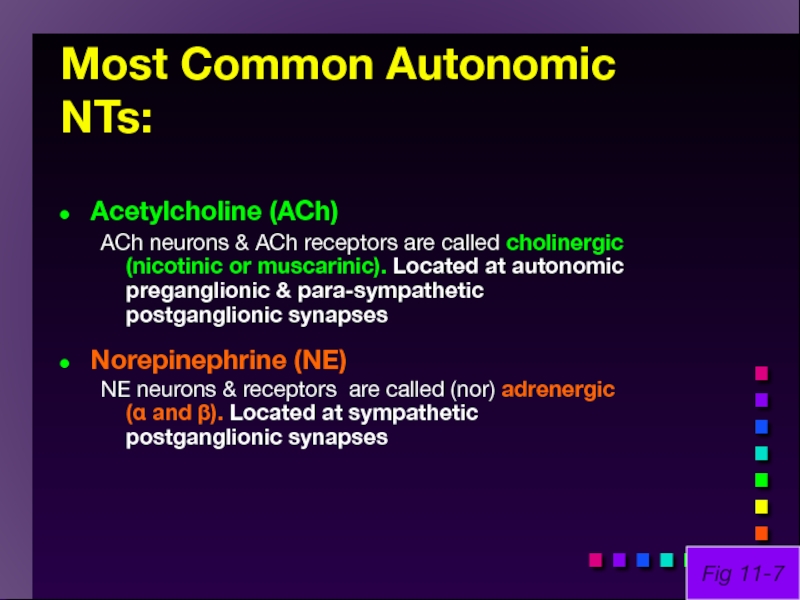
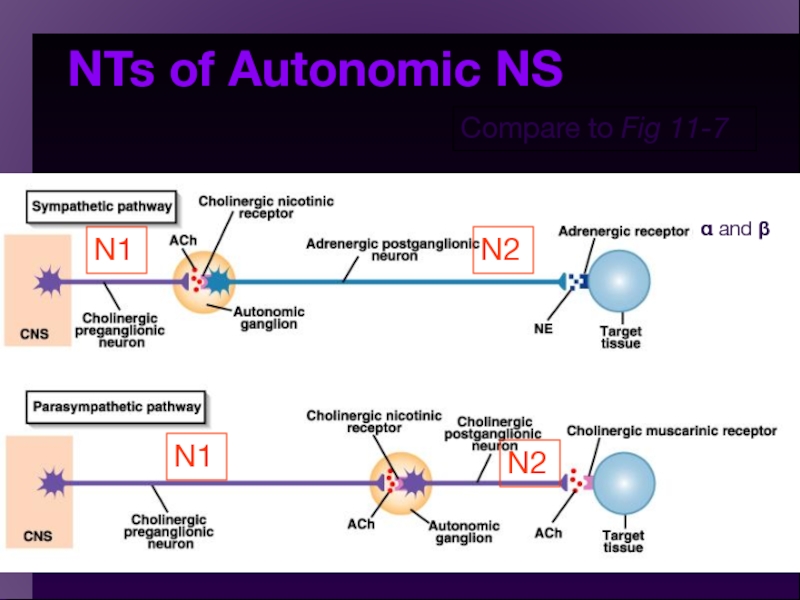
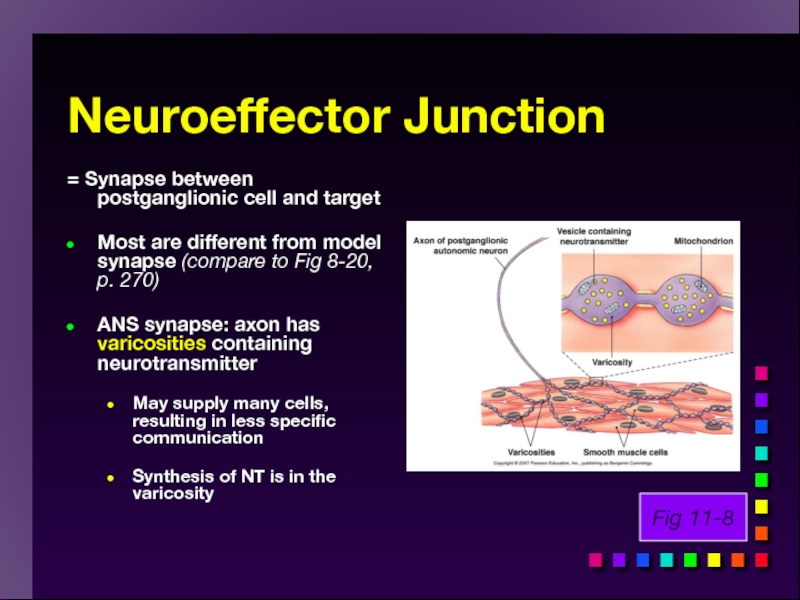
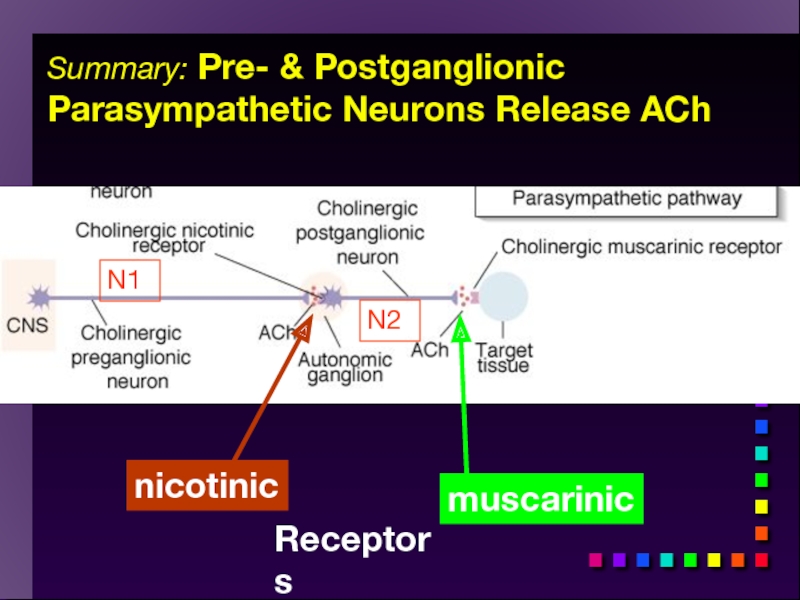
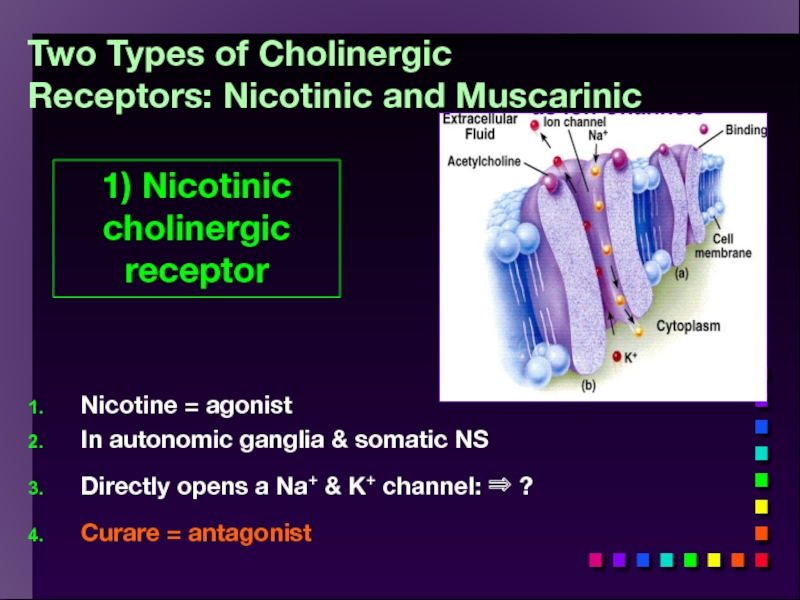
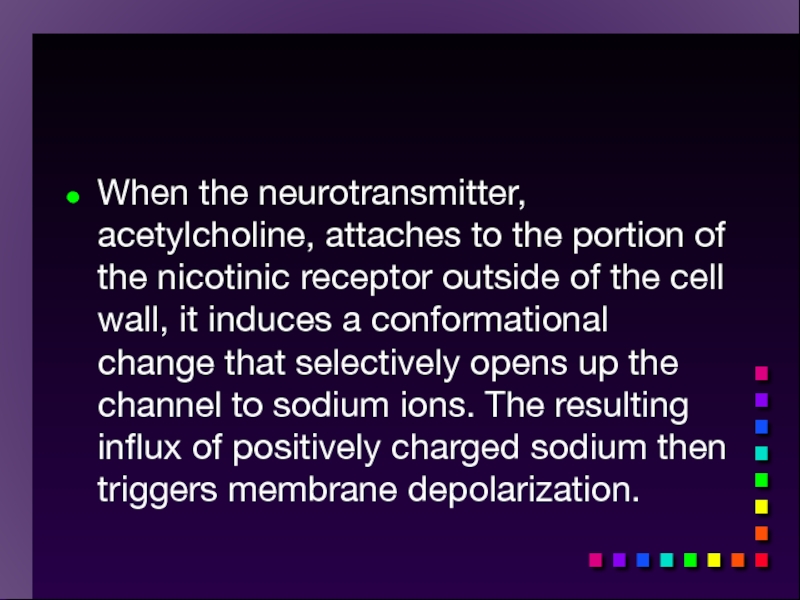
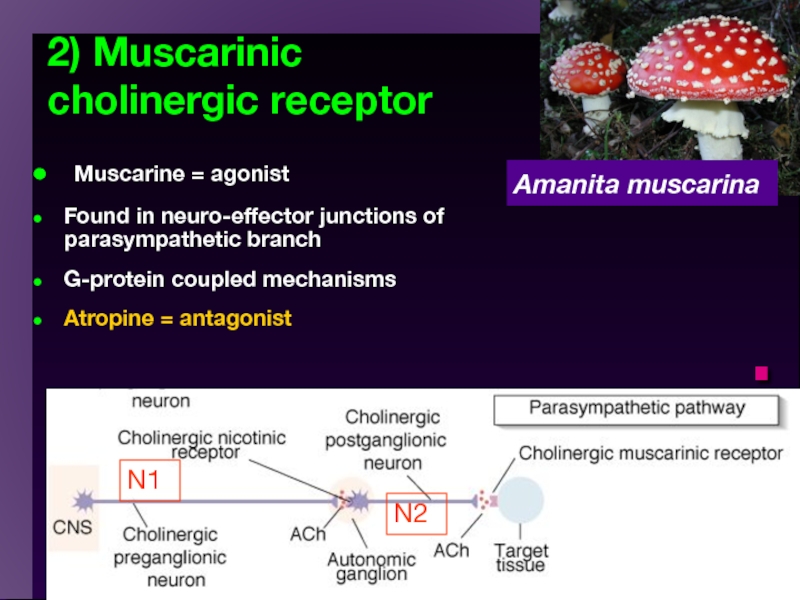
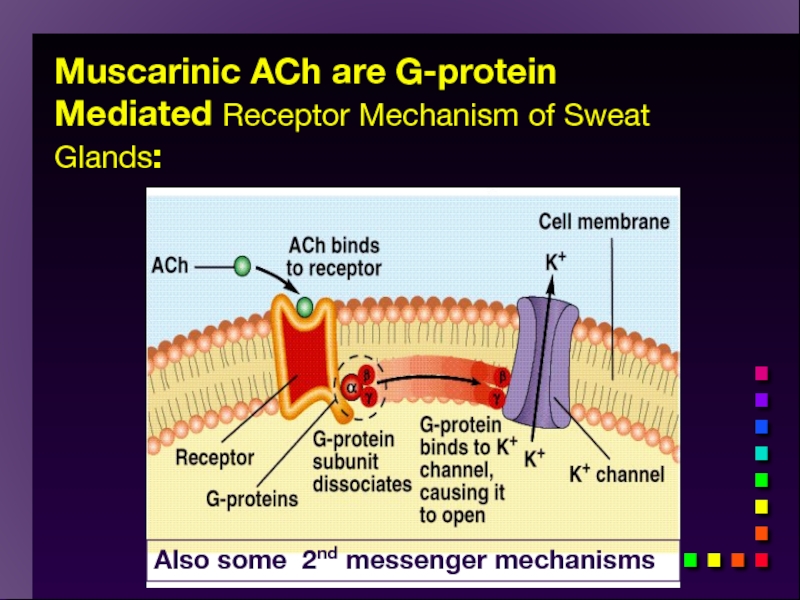
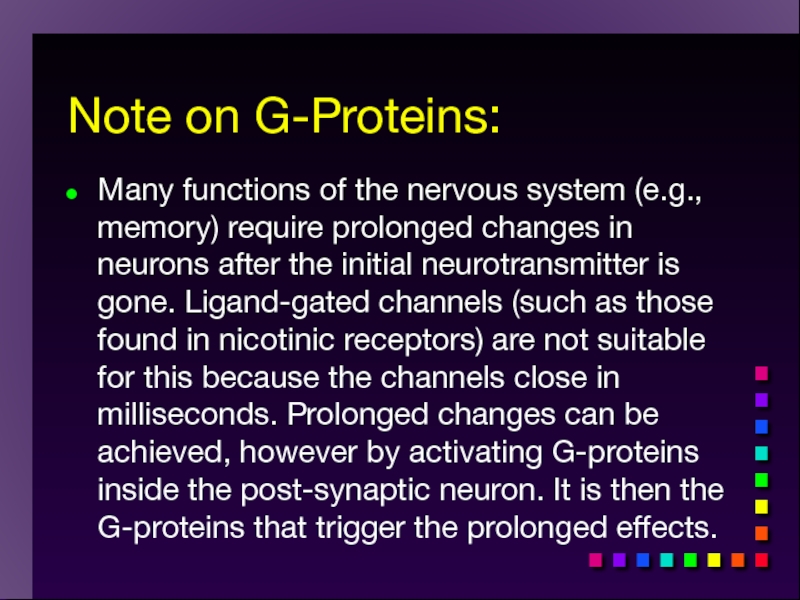
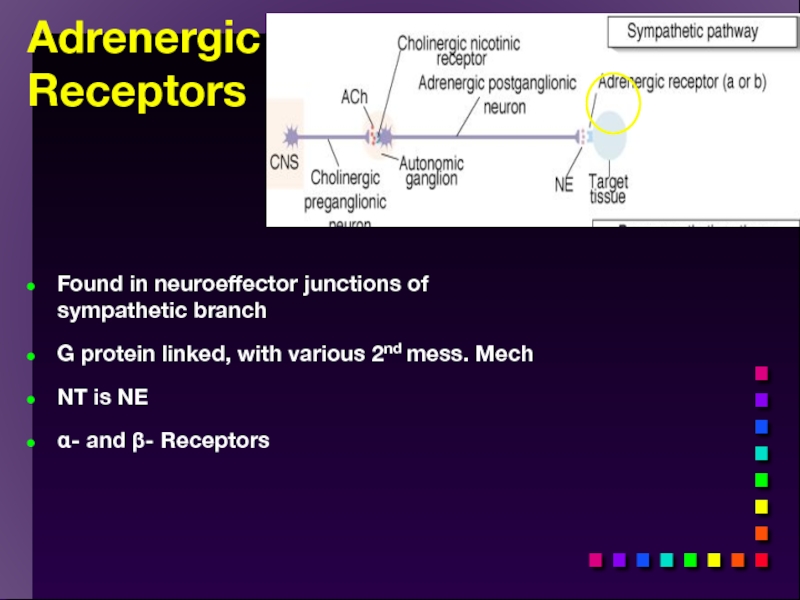
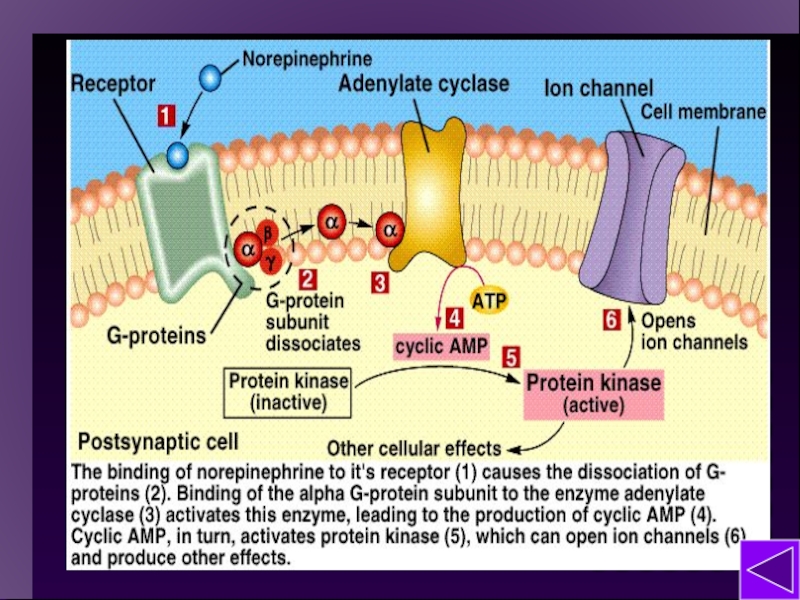
![Sympathetic Receptorsα Receptors: NT is NE (most common) ⇒ Excitation [Ca2+] In↑ ⇒ muscle contraction](/img/tmb/5/424170/f322ead1caac437c4c1c6e1e7635a3a1-800x.jpg)
![β − Receptors Clinically more important β1 ⇒ Excitation heart ([E] = [NE])“β - blockers”](/img/tmb/5/424170/b7f9bd7689faa619eb20410b11d9726e-800x.jpg)
